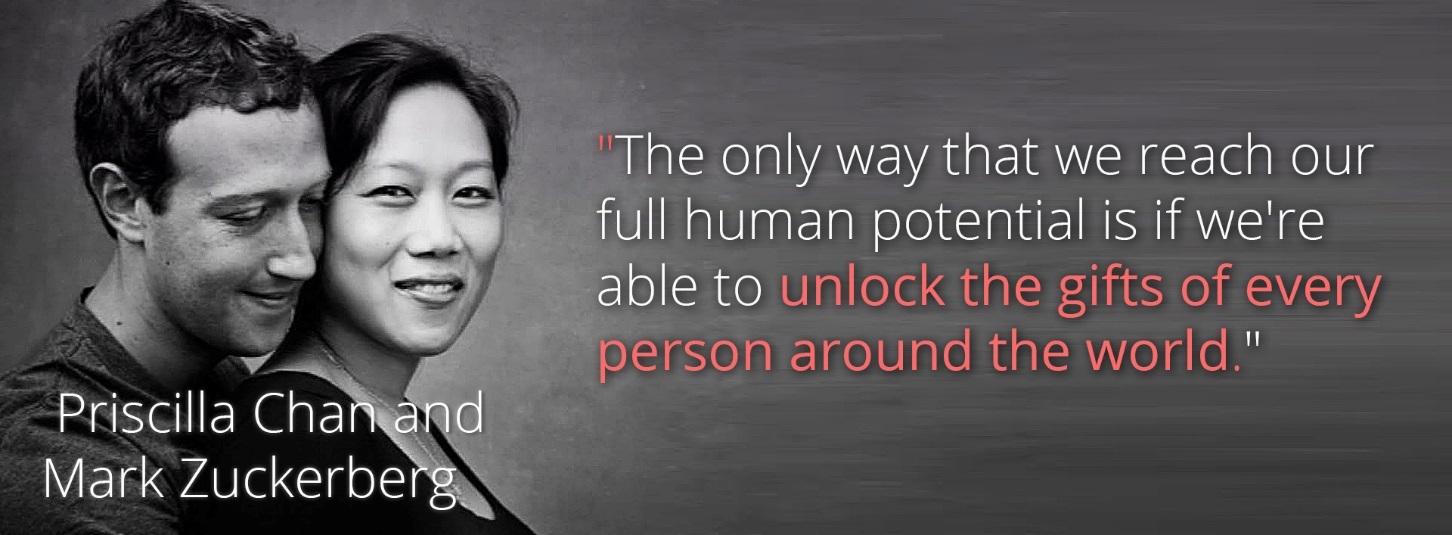The S-Web CMS Framework
Chapter 1. The S-Web CMS Framework
By Nick Ray Ball 2nd July 2017
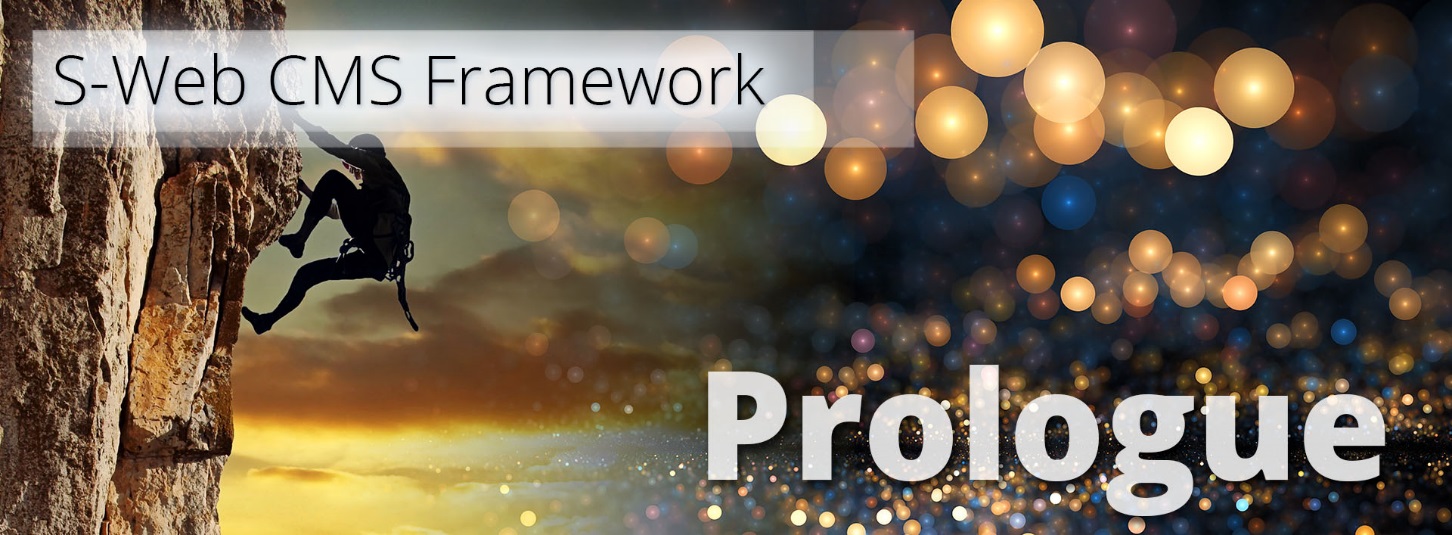
Prologue…
Before we delve into chapter one, a quick focus point for to the two principle recipients of this book: The ChanZuckerberg Foundation and leading high-end real estate companies.
We are not providing websites, CRMs, or software to replace an existing company’s systems. We are providing bundled websites and systems for companies or individuals to start new ventures. In this example, we focus on creating a vacation rental division for a real estate agency, including a bouquet of nine agency websites and 16 individual villa websites for use when gaining sole rental mandates, plus access to significant systems and software that we have made and are making that make the venture simple to manage and extremely profitable. We call this option ‘the primary network,’ which for various reasons we prefer to be run/owned by a successful real estate company in the locations we are focusing on: Cape Town, California, and Hawaii.
Once the primary network is established, we create web and software packages for other individuals & companies to join the network. Most of whom will focus on the acquisition and marketing of sole rental mandates, which due to what we have labelled ‘prestige marketing’ and ‘the estate agents packs,’ will mostly turn into sole mandates for sale by the real estate company’s ‘primary network’ when it’s time to sell.
For the real estate agencies, these systems make the job of managing what many real estate MDs & CEOs have traditionally considered a very manpower intensive division a lot simpler to run, with potholes and potential landmines avoided. A fundamental component of Villa Secrets primary and other networks is that until they become as profitable as to warrant C-Suite management interest, they can pretty much run themselves. And the only reason they can do so are the systems presented in this chapter and throughout this book.
In terms of for sale mandates, in chapter 19 ‘Real Estate Systems and Wins,’ we break into game theory and present the hypothesis of how many property sales will be made by the primary network in future years. Not exclusively from the mandates won by the real estate agents new ‘primary network’ but instead all the companies in the network.
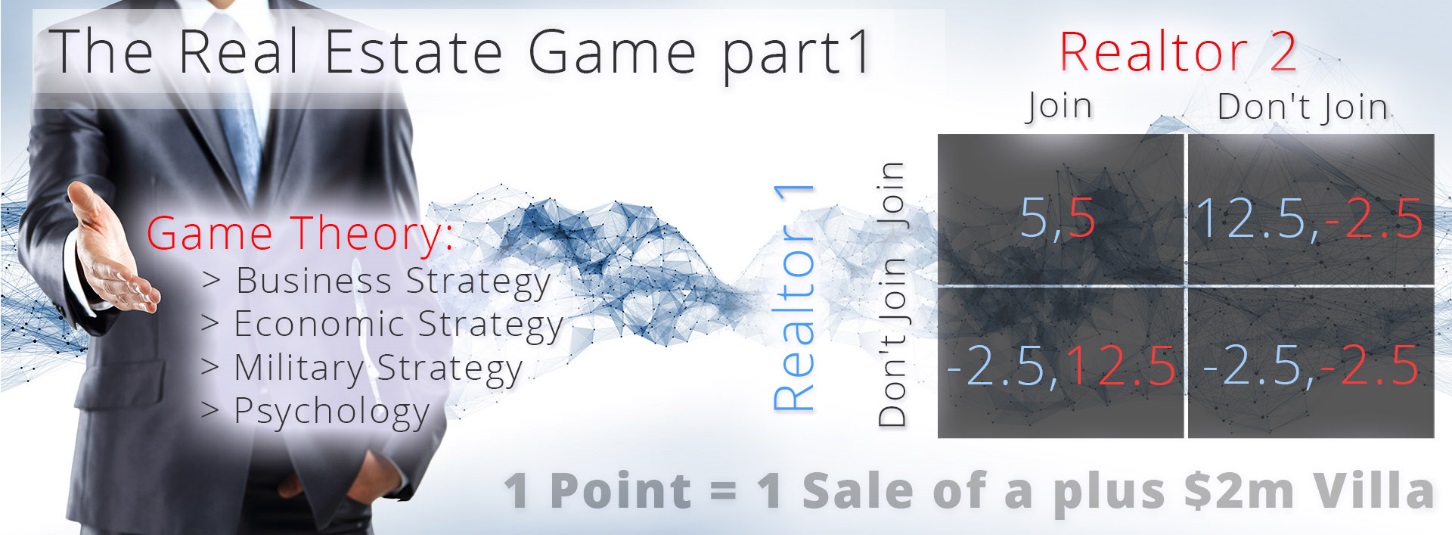
In chapter two, we listed dozens of company types that can recruit sole mandates. For instance, an architect’s portfolio of current and previous clients; a property developer who has completed a new set of luxury apartments; private Islands and leading safaris providing multi leg options to their clients or making money from their ‘overflow’ (options to book alternate venues when their venue is booked); and a villa owner or property manager who is already making residual income from their ‘overflow’ can turn this side-line into major income stream.
Or for instance, a relative or friend of a luxury villa owner who has jumped on the Airbnb property manager bandwagon promised/expected a good return, but has found that it’s not that easy at the top end; or a villa rental company that just has not kept up with technology and is struggling with the new breed of competition that VRBO (vacation rental by owner) websites have caused.
The list goes on and on… but the headline is ‘Most companies will recruit mandates that only the real estate partner can sell.’
When we estimate property sales in chapter 19, we do so from the mandates, clients and opportunities gained by all companies in the network. And it is for these companies and the monitoring of them that the following systems are essential for.
Lastly, in creating these systems we fulfil on our initial claim to the Chan Zuckerberg Foundation that we can create the environment necessary for people to reach their potential, as all the pitfalls and landmines associated with starting and running a business have been cleared away, and the individuals and teams running them can focus on developing their strengths, not admin and businesses administration. And they can do so from the starting point of having a better web presence and superior systems to their competitors (or at least equal to big spending competitors), safe in the knowledge that over time the web framework and systems will continually be improved upon, pressing home their advantage.
Chapter 1. S-Web CMS Framework
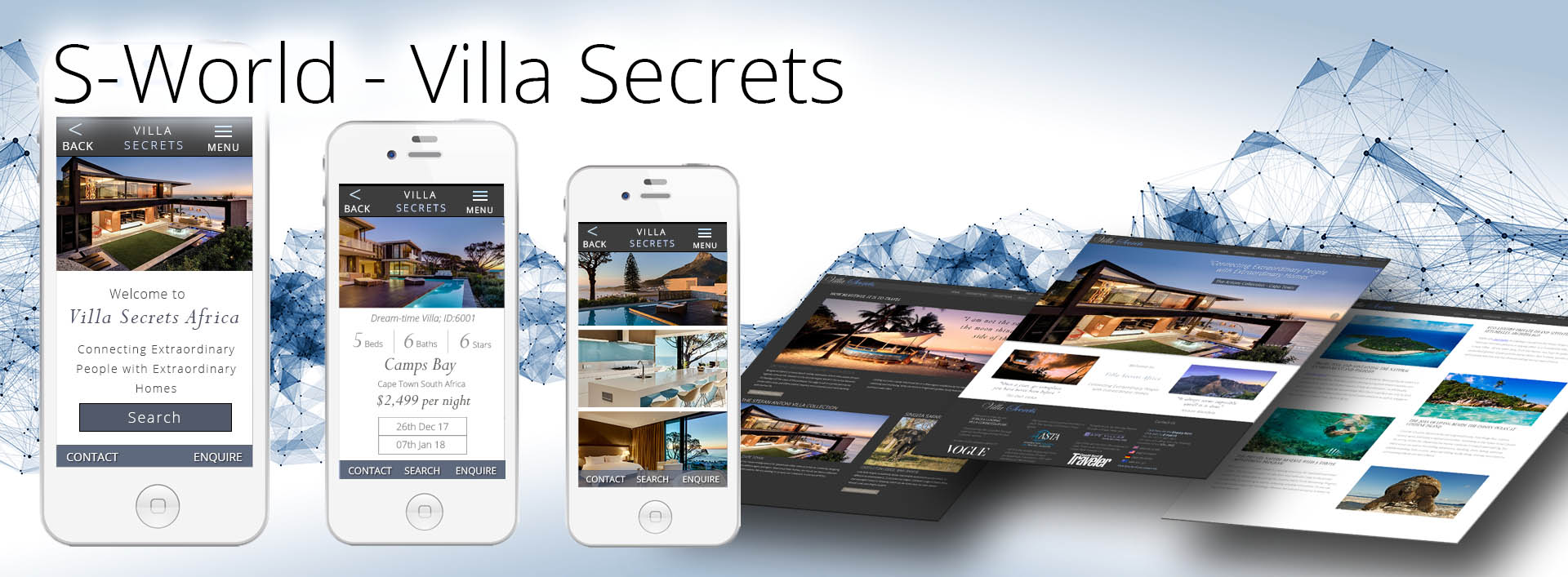
In this, the first chapter we follow the ‘Challenger Sale’ prescription which demands five discrete steps before presenting our product.
To recap, The Challenger Sale is the best-selling book on B2B complex and bundled solution selling by Matthew Dixon & Brent Adamson; Managing Directors with The Corporate Executive Board’s Sales Executive Council, which serves more than 200,000 business leaders across roughly 4,800 organizations in more than 50 countries, which gives them a wide angle on any business issue.
For each of the 6 steps recommended by Dixon & Adamson, we shall begin by highlighting their advice on what each step should contain,
in a bolder font
.
S-Web CMS Framework
Challenger Sale Step 1. The Warmer

Dixon & Adamson:
‘Build credibility and show your prospective partners you understand their challenges.
It’s an approach we have dubbed ‘hypothesis based selling’ rather than leading with open ended questions about customer’s needs, instead lead with hypothesis about customer’s needs, informed by your own experience and research.’
With a touch of irony in making the case for this action, the first research we shall present is from the CIO Executive Board. It’s a little old but it makes the point.
In 2009 the CIO Executive Board found that only 26% of business leaders rated their IT departments as effective. And in a study of 5,000 staff members 76% of staff disagreed with the statement “has their job performance improved due to a new system delivered by IT.”
Websites, Integrated Software & ‘Wow & Awe’
When it comes to creating a new business or product line (in this example vacation rentals) in a market that is internet and affiliate driven, in most cases the first thing most customers see (be them direct or trade) is one’s website. The more engaging and awe-inspiring your website, the more of an emotional connection you will make and the more likely a customer is to enquire and book. We call this ‘Wow & Awe.’
Once a client has enquired, it is then down to the skills of a sales representative to use the systems at their disposal to source and present stock (villas/exclusive use safaris and private islands) to the client, and seek to make the booking.
Before going into further detail, we need to describe what our definition of a system is. In context to S-World Villa Secrets, a system can be a software, a part of the website, a human resource (staffing), or anything that assist the sale process, even just ‘picking up the telephone,’ if this action is prompted by the software, or part of the operations manual.
Whatever systems one uses, one will almost always refer to a website. On the telephone, one will ask a client to look at pages ‘x, y & z,’ whilst talking the client trough the options. By email one will provide links to the website. CRM software (customer relationship management) should be intrinsically connected to the website, and your accountancy software should be equally connected.
Why should CRM & accountancy software connect to your website? Well there are many reasons but for one there is no need for data inputting (from website to CRM or accounting software), and this adds a layer of security that greatly reduces errors and fraud, it saves staff time and enables one to do the job of many. In addition, if financial and CRM data is connected to your website, one can present the data to the client in real time in their client suite.
Getting back to the website itself & ‘Wow & Awe!’
If one was in the mood for a new website suited for a large vacation rentals or real estate company, one needs a website with a CMS (content management suite) that is not only simple for staff to use, but also it should be kind of fun, and if possible addictive. As in our 17 years of experience with various companies and websites, from www.CapeVillas.com to www.ExperienceAfrica.com & www.Cape-Town-Luxury-Villas.com to www.VillaSecrets.com, we have found in all cases that a company that adds about 100 properties a year will double the performance (gross profit) compared to a company that only added a dozen or so properties. The more engaging, simple, and quick to use the CMS is; the more it will be used by staff.
As David Hoffeld presented in his book ‘The Science of Selling,’ one must avoid anything boring, and as neuroscientist John Medina confirms, “When the brain deems something uninteresting it will disengage from it.”
In short, Bored Clients don’t buy and Bored Staff don’t use…
Be it the CMS or the CRM, getting staff to use the systems in the first place is often a struggle. And chances are whoever created their CMS was not thinking about how to also make it fun and addictive. In many cases it’s as much as one could expect, for it to just be simple.
There are three types of CMS:
- CMSs like WordPress which help web designers make very attractive smaller websites.
- CMSs within bigger custom-made websites, so staff may add products to the website.
- CMSs for creating mobile websites often used to upgrade older websites and legacy systems
1. CMSs like WordPress which help web designers make smaller attractive websites.
In the case of WordPress, the CMS is very powerful and adaptable, and when using it one can visually create just about anything. It comes with thousands of different themes that create the most up to date look for a website. However, as the CMS for WordPress has been designed for any situation, it has a thousand functions that are not needed to add a property/product that can get in the way, and so one needs to spend time teaching each staff member how to use it, and even with training some staff still struggle.
We did this a few years back when we created the Villa Secrets Blog, http://blog.villasecrets.com. If we look at an individual product page such as this one: http://blog.villasecrets.com/african-safari/ulusaba-african-luxury-safari-in-sabi-sand we can see it really does make the property look good, and these enhanced pages went down very well with clients, gaining an emotional ‘wow & awe!’ response every time.
The trouble was the pages took a long time to make even when one has all the photos and copy. To add all the photos and copy to the websites took over 90 minutes, and to make the image slider at the top took over two hours for an experienced WordPress web designer. So, we could not add a page quickly and we could not add the image slider at all without assistance from an expert.
In addition, WordPress is not built for many products, unless you create your own theme one can’t customize the file structure. It does not have a nice clear list of pages/properties added, and the way photos are stored is not ideal either. But the bigger problem was that despite having a standard MySQL database that one can fetch data from, when it came to connecting systems or another website to WordPress and adding data to the WordPress website, one needed to create a dedicated plug in, each time, for each system which is a time-consuming specialist discipline.
And for these reasons, despite the great looks and versatility of WordPress for making smaller websites, blogs or bespoke displays (if you are reading this on a website, then you are reading this on WordPress), it’s not a solution for creating larger websites that require multiple API and other web based connections to software and systems. Unless one is happy to only use the systems that have already been created as plugins, which are an awful lot, but not nearly what we desired or needed.
Maybe in a few years this may change if everyone makes a plugin for WordPress for every system, and people made theme’s specifically for bigger companies. But right now it’s not the right tool.
2. CMSs within bigger custom-made websites, so staff may add products to the website.
With WordPress and similar CMS web solutions off the table, to add a simple to use CMS for staff to use, one needs to look at a custom-made website, or an adaptation of a custom website already created by a web developer.
In many cases for large custom-built websites, a web developer will use a web framework such as Zend. A web framework is designed to support the development of web applications and alleviate the overhead associated with common activities performed in web development. In other words, for items like CMSs, enquiry pages, currency convertors and other functions or pages one customizes a page that has already been made within the framework. And whilst this is useful, the pages created are mostly uninspired, and often boring, and in particular the CMS and other back end systems.
To customise the framework to create the product pages to the same degree of ‘wow & awe!’ as seen in our WordPress experiments would take a long time, require various experts, and be expensive. In addition, if one wishes to add to the website, say for instance an ‘online magazine’ or a system for agents to create dedicated webpages for clients (particularly useful in the mobile world we live in), the reliance on the web framework by the developer may hinder such progress. And of course, unlike WordPress, it’s completely impossible to add to or adjust the website design in any way without the web developer.
Lastly, websites get old both in look and code, and only the most successful companies can afford to completely overhaul the website every few years.
3. CMSs for creating Mobile websites
Lastly in the world of web frameworks and CMSs we have the increasing important mobile frameworks, and in this category http://jquerymobile.com is the market leader and like WordPress is free to use.
One does not need such a framework for WordPress and other ‘all industry’ modern CMS web frameworks, but one does if one needs to attach a quality mobile component to Zend and other frameworks, or custom-built websites that did not build for mobile, or legacy (old) websites that are all poor on mobile.
We tested JQueryMobile in 2015 and created a good looking mobile website for Villa Secrets. See http://m.villasecrets.com (only view on mobile, only 80% complete), but despite its good looks and simple functionality, working in this way was not ideal, as one effectively has two different websites. And when it comes to development of adding a new section such as the previously mentioned ‘online magazine,’ one needs to develop it two times, once for desktop and once for mobile so increasing the cost, and the chances of something going wrong. Plus, its poor SEO, say Google as a link to one page on desktop, will not count to the same page on mobile and vice versa.
In Conclusion
To create a large-scale website with more than 100 products, including a custom-built attractive simple CMS that staff can use without need for training, that has the very best design as featured in the best WordPress themes, that can be connected via API to booking systems to provide online availability & booking, which also performs and gives ‘wow & awe’ across the variety of device sizes from desktop and hi-res laptops, to tablets and mobile; you need to hire a top web development company who already have such websites in their portfolio, and that will cost a lot of money.
If only there was a system that has the best of all worlds, the Wow and Awe of WordPress, the simpler XML connectivity of custom websites, the mobile presence of JQueryMobile with a CMS that was simple, kind of fun to use, and even addictive.
Step 2: The Reframe
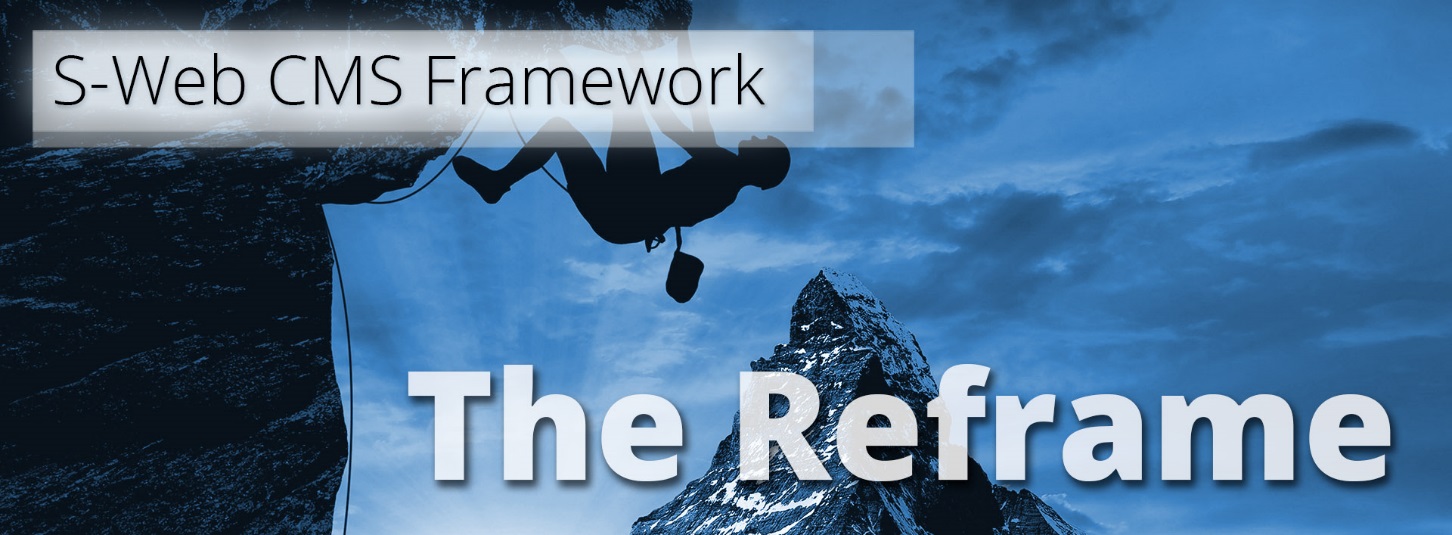
Dixon & Adamson:
“Building off the challenges presented in step 1, introduce a new perspective that connects those challenges to a bigger opportunity than hadn’t been previously considered. This is not the place to be timid as the entire approach rests on your ability to surprise and make readers curious for more information.
However, the reframe is not about the incite itself, it’s just the headline, and like any good headline your goal is to catch your customer off guard with an unexpected viewpoint, to surprise them, make them curious and get them wanting to hear more. The response one is seeking is for the reader to say: ‘Huh, I’ve never thought about it that way before.”
Limited only by our imagination
At the end of the last step we postulated: If only there was a system that has the best of all worlds, the wow and awe or WordPress, the simpler XML connectivity of custom websites, the mobile presence of JQueryMobile with a CMS that was simple, kind of fun to use, and even addictive.
However, that’s not all he wrote. In creating a system that has the qualities that WordPress provides but with a custom-made CMS that is not only simple it’s fun to use and addictive, one actually creates a framework from which you can develop software into the system in a way that no other big company has. And in a way, that’s infinitely simpler than working with a handful of different systems by different developers connected together to create a complete solution. And in development simplicity is a very valuable commodity.
If one develops software inside the S-Web framework, so that the software was an extension of the website, one could build a CRM into it. If one could do that one could automate the website, one could use the enquiry data and search criteria to create automatic communications with clients that looked and appeared human, and it could automatically email bespoke villas (properties not on property inventory systems), and as soon as the availability was confirmed it could send the client an update.
One could automatically create the perfect email for a client, and present it to agents who are out of the office or out of work hours, which would only take them a minute or two to check on their mobiles and send as a reply to the client. We know from experience that agents that answer enquires and respond to communications out of work hours can double the sales figures of those that don’t. So, it’s no small point.
In fact, one could do just about anything if there was just one system instead of many. If the software was a part of the web framework, one’s limitations are no longer technical in nature, rather they are only restricted by one’s imagination.
What if one could create a company controller within the CRM that organised the functions of all staff and management, and what if it could give a score so that each day each team member had the opportunity to score more points and win the day.
What if… What if…
What if when one added a product to the CMS, it gave 10 points, and more points each time someone viewed the page, and 100 points every time someone booked it, and those points were liked to profit-share, bonuses, and commission. This changes the dynamic of adding properties and searching for mandates, and brings the whole team on board, and focus them on finding properties that will make bookings, as each booking made adds points and so more profit share.
What if there was a management game running in the background that showed everyone’s score and a bunch of tutorials in how to increase it? That when acted upon improved the bottom line of the company in over 80 different ways?
Would that make the CMS fun?
Would that make it addictive?
Would that focus the team on tasks that were important to the bottom line?
Dixon & Adamson:
So what’s next…
You have shown your customer a different way to think about websites CMSs and systems, now you have to show them why it matters!
Step 3: Rational Drowning
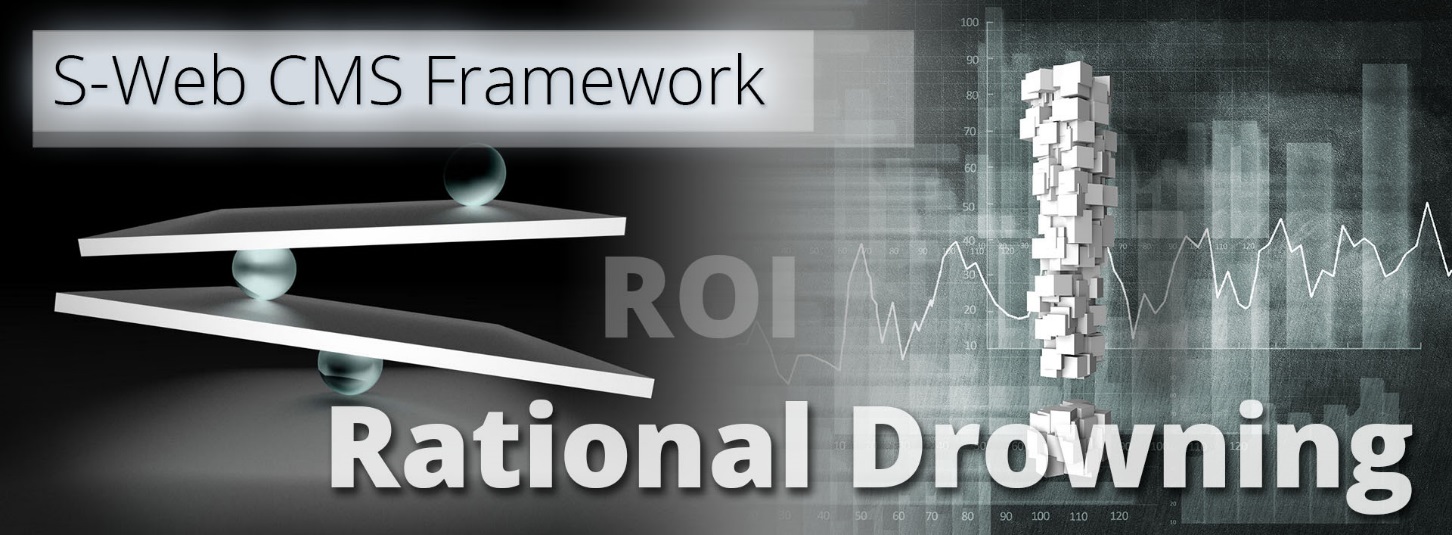
Dixon & Adamson:
Next, show prospects the numbers behind why they should think differently.
Rational drowning is where you lay out the business case for why the reframe in step 2 is worth your customer time and attention.
In 2015 in a meeting with Rhino Africa (arguably the world’s No1 safari orientated tour operator), Rhino Africa revealed that their ROI (Return on Investment) from Google AdWords was over 600%. This was at first puzzling, as we fancied ourselves as masters of Google AdWords, but were only getting a 300% to 400% return. This puzzle was made the more perplexing due to greater completion for African Safaris vs Cape Town Villas.
However, it did not take long to work out why they were getting this 600% return, it was their systems, which they made mention cost more than $1million. It was Rhino Africa’s systems that turned what would have been a 300% return into 600%.
All one needs to do to move that 300% ROI to a 600% ROI was either double the number of enquiries one received from their website adverting, or double the amount of bookings made from each enquiry.
And if one could both double the amount of enquires one received from their website, and double the amount of bookings made from each enquiry one would turn that 300% ROI into 600% ROI and then 1200% ROI (a 400% net gain on the status quo).
Intrinsically linked into the S-Web CMS Framework is what we call ‘The TBS™’ (Total Business Systems), which is all the web components and all the software described in this book, as summarised in chapter 14. This chapter provides over 80 separate systems, from CMS, to CRM to staffing. For instance, a call centre and live chat open 7 days a week in European and US time zones speaking different languages to assist the sales process we believe may increase ROI as follows:
| Villa Secrets Call Centre & Content Marketing | Max Effect | Phase 1 Effect | |
| 24/7 365 Call Centre and Sales Team |
40.0% |
|
13.2% |
| Foreign language Sales Teams |
35.0% |
|
11.6% |
| 24/7 Live Chat (USA, Asia Time zones in Multi Languages) |
25.0% |
|
8.3% |
| Content Writing 1 |
20.0% |
|
3.0% |
| Subtotal |
100.0% |
|
33.0% |
Note: The figure on the left (100%) is the figure we feel can be achieved after a few years with an experienced 24/7/365 team. Whereas the figure on the right 33% is what we expect at the end of phase 1 (when gross profit = R10milllion / $765,000, expected by the end of 2018).
Please note that 33% is a low estimate considering the huge advantages it would bring, we always err on the side of caution when making software ROI forecasts.
Next we see the ROI that is expected from the web framework itself, again a low estimate, as this is in comparison to the prototypes www.capevilas.com and www.cape-town-luxury-villas.com which are now both outdated and are just awful on mobile.
| S-Web Villa Secrets Web Framework | Max Effect | Phase 1 Effect | |
| Superior Visual Experience |
15.0% |
|
11.3% |
| Greatly Superior Mobile Experience |
20.0% |
|
10.0% |
| Advertise on Mobile Platforms |
10.0% |
|
7.5% |
| Subtotal |
45.0% |
|
28.8% |
In total, there are currently 88 different single systems presented in full in chapter (14) that combine to make the following:
| Total (Complete or in progress Systems) |
699.5% |
|
248.6% |
|
|
|||
| Other TBS™ & M-Systems |
488% |
|
64.5% |
|
|
|||
| Competitors and Other Negatives |
-225.0% |
|
-113.5% |
|
|
|||
|
Total |
1122.0% |
|
208.90% |
‘Total (Complete or in progress Systems)’ are the systems that are described in the various dedicated chapters in this book, that have either been developed or are being developed, items in development are due for completion in 2017 and 2018 per the development schedule found in chapter 20.
‘Other TBS™ & M-Systems’ are items in or due for development that have not becomes part of a specific project/chapter
‘Competitors and other Negatives’ are significantly overestimated items that may negatively affect performance such as the rise of Airbnb and other competitor improvements.
What this is telling us is that when working on lowest success probabilities, at the end of phase one we should expect to increase ROI from online and other adverting by 209% and that by the time we have completed the entire system it can create a much greater affect.
A 209% increase to an average 300% ROI from Google AdWords changes the return to 627%, and as importantly makes lower ROI adverting such as advertising in Condé Nast Traveler into profit making advertising choices.
Primary Network – Villa Rental Agency Returns
Scenario 7

In 2014 we launched the prototype for Villa Secrets www.cape-town-luxury-villas.com, and in 2015 using only Google AdWords it created almost as much income as www.capevillas.com which had 13 years of trading experience. Collectively the duo of websites had only one rental mandate and no systems whatsoever. The combined GP (Gross Profit) was just over R3million / $230,000.
In 2016, we created 6 forecasting scenarios that used different strategies, and as we did the Villa Secrets business plan became more detailed, to the point where it is now longer the average novel.
In chapter 18, we present the 2017 ‘Scenario 7’ and the first phase of the Villa Secrets primary network offer which adds 7 more websites, all of which will use the new ‘wow and awe!’ web framework. In addition, we desire the managing company to secure 6 exclusive rental mandates each year (see chapter 3) and we have the S-World TBS™ systems improving all returns by up to 209%.
Phase one is to achieve R10 million / $765,000 within a 12-month cycle, and given all the above, that’s a simple enough statistic to agree upon, given that just two sites with one mandate and no systems made R3million / $230,000. Then 9 Agency websites, 6 mandates each with their own website and dedicated marketing, multiplied by the 209% worth of systems, can make over R10 million / $765,000
In scenario 7, stage 1 share holder profit is estimated a R2.7million / $200,000. However, it is recommended that all profit in phase one be used for profit share and mandate marketing, as the point of phase one is to arrive at stage two as quickly and efficiently as possible.
By rights, in stage 2 we should increase the S-World TBS™ profit multiplier from 209% as more systems will be completed, improved upon, or added to. However, as we really did not need to, we just left it at 209%. But even with this limitation, when including another 6 rental mandates stage 2 gross profit (estimated for 2019 or 2020) is just shy of R40million / $3million, with shareholder profit before profit share at R14million / $1million. At which point, the division becomes worthy of the attention of the real estate companies C-Suite officers.
The complete cost for the primary networks agency websites and all software systems (chapter 20) is R2.2million / $167,772 plus a 12.5% of GP (equivalent to only a 2.5% of turnover franchise fee ) ongoing development contribution. With only 25% R550,000 / $41,943 payable on signing with the balance paid in 12 discrete steps over the following 18 months, each step liked to a website or software system being completed per the development timetable.
Skipping past stage one, as profit is desired to be reinvested, if we compare the cost of the primary network R2.2million / $167,000 to the stage two scenario 7 projection of R14million / $1million we have a ROI (Return on Investment) of 670%.
To put that into perspective…
If one were to put $167,000 in a US or UK bank, one would receive between 1% and 2% interest each year.
A good return from investing in the stock market is 10% per year.
A fantastic return from the stock market is 25%.
Villa Secrets Primary Network 670%
Sounds too good to be true? Well really that’s the point, that’s what disruptive change is all about. So long as the real estate agent can bring in the 6 rental mandates each year, which given we present 19 different ways to acquire mandates and most agents at the real estate company will likely know at least one prospect, is more than achievable. In fact, it could be doubled, or even trebled.
However, another way to look at it is not that one is making a 670% return, but instead that one is making a reasonable return on an opportunity that should cost over $1million in the first place. So instead of a 670% return, one is initially receiving a 670% discount (See chapter 20 for valuations of the true value of the primary network opportunity).
Further… according to ‘The Challenger Sale’ the best-selling book on B2B complex and bundled solution selling by Matthew Dixon & Brent Adamson; Managing Directors with The Corporate Executive Board’s Sales Executive Council, which serves more than 200,000 business leaders across roughly 4,800 organizations in more than 50 countries.
“In a recent survey of B2B customers the marketing leadership council, found only 35% of companies able to establish themselves as truly preferred over the competition.
And still more troubling, even among preferred companies when we tested the impact of each of the benefits they believed to be unique, we found that customers perceived only half of them to be relevant to their needs.
When you put it all together, only 14% of companies so called unique benefits were perceived by customers as both unique and beneficial.”
It’s astonishing…
“Only 14% of companies so called unique benefits were perceived by customers as both unique and beneficial.”
That means that 6 out of 7 companies have nothing unique or significant about them at all. Whereas throughout this book, we present well over 50 unique systems that are all beneficial to the bottom line.
As such the math says that statistically the Villa Secrets’ Secrets is 350 times more innovative compared to the average company. And this before we even get to the advanced M-Systems design.
If a company is 350 times more innovative than its competitors, it is truly disruptive.
Chapter 19. Realtor Systems and Wins

Unlike the 7 villa rental forecasting scenarios, which are based on decades of expertise and various prototypes with various managers, when it comes to for sale mandates we do not have a crystal ball. But we can be sure that most rental mandates will turn into sale mandates for the following reasons:
Villa Secrets has a unique ‘rental mandate turns to sale’ commission system, where over half of the rental commission is used for what we call ‘Mandate Marketing’ and half of that is spent on ‘Prestige Marketing’ which puts the villa in magazines like Condé Nast Traveler and Vogue, and prime placement in the Villa Secrets Coffee Table books, to be compiled with other items into estate agent’s packs. For use if and when the owner wishes to sell, or if a high roller buyer is interested and offers top dollar for a villa that is for sale, but only at the right price.
This being so, we can apply a formula that is relative to how many mandates the entire local network is estimated to gain, to estimate how many for sale mandates will be achieved
In chapter 19 we break into game theory to see how this will impact real estate agents, below we see a game we are developing. The initial conditions are that in Cape Town including the Atlantic Seaboard, City, Waterfront, Constantia and surrounds 100 villas are sold a year for over $2million. And that there are 3 market leaders that account for 50% of sales and a collection of about 7 other companies that account for the other 50%.
The Estate Agent’s Game 1 – Capture Market Share
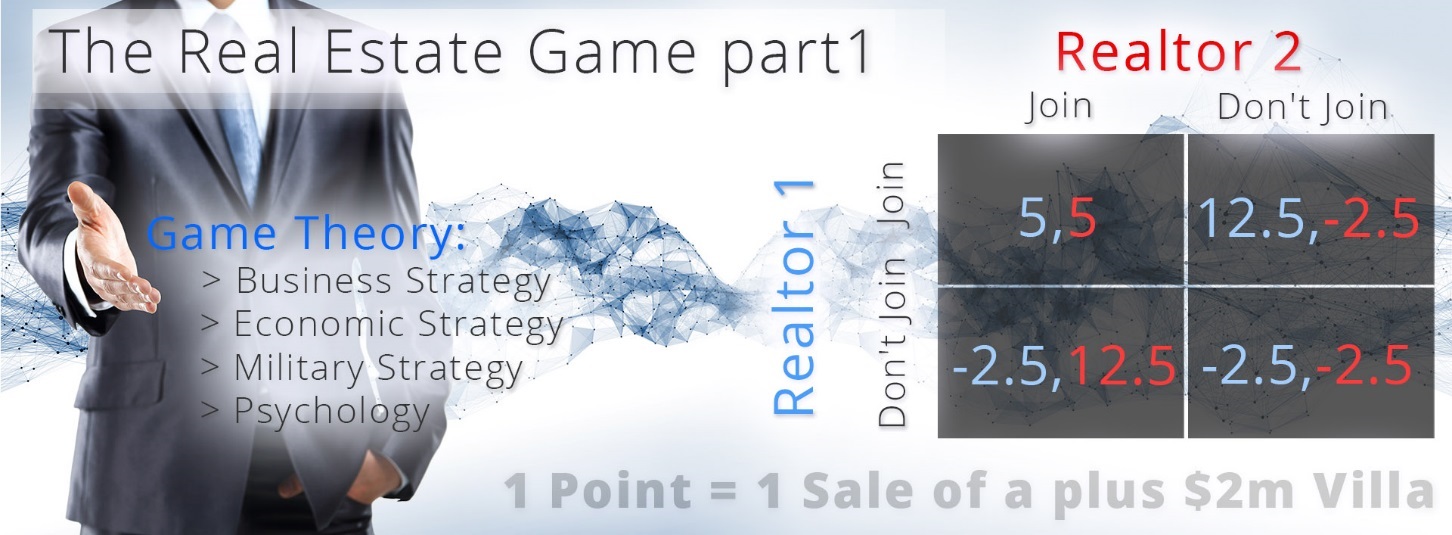
Above we zoom ahead to 2020 and assume Villa Secrets has delivered on its network ambition and a large network of companies and individuals have collectively amassed 100 villa rental mandates, of which fifteen are sold via the Villa Secrets partnered real estate agency (the primary network).
In this scenario, we deduct the 15% loss in market share evenly across all agencies, so the three-big agency decrease their market share by 2.5% each. Which is the cost of not joining the network. There is a dominant strategy for only one real estate agency to join the network, and in that case it would increase its market share by 12.5%, increasing their sales of villas over $2million from 17 to 29 and an increase of 75% to the agency itself.
If two agencies joined, both would increase market share by 5 villas over $2million from 17 to 22, an increase of 30% per agency.
This would be a great result for any real estate agent, a 30% or 75% increase in sales of the most expensive properties, and as success breeds success this figure could increase as owners come to Villa Secrets ‘primary network’ not just to rent but also to sell.
Another more ambitious game is created, that includes the factor of ‘Jet Set’ marketing, which seeks to connect with private islands, exclusive safaris and other expensive properties to bring more Jet Set clients to Cape Town in the first place, not taking market share, increasing it.
If we get this right and double the amount of Jet Set clients, we expect a far higher return for our partner real estate agents, and a Nash Equilibrium (a win/win) for all real estate agents, regardless of whether they are in the network or not, albeit as we can see the benefits of this scenario are colossal for the estate agency or agencies that join the network.
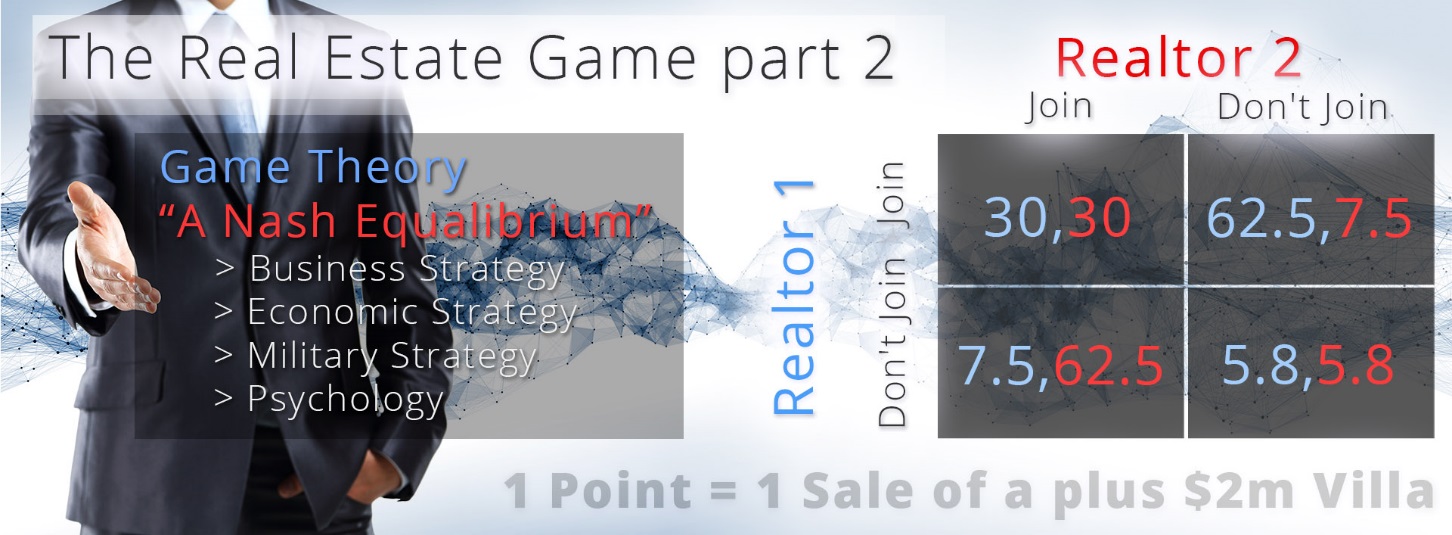
For more details, see chapter 19.
Step 4. Emotional Impact
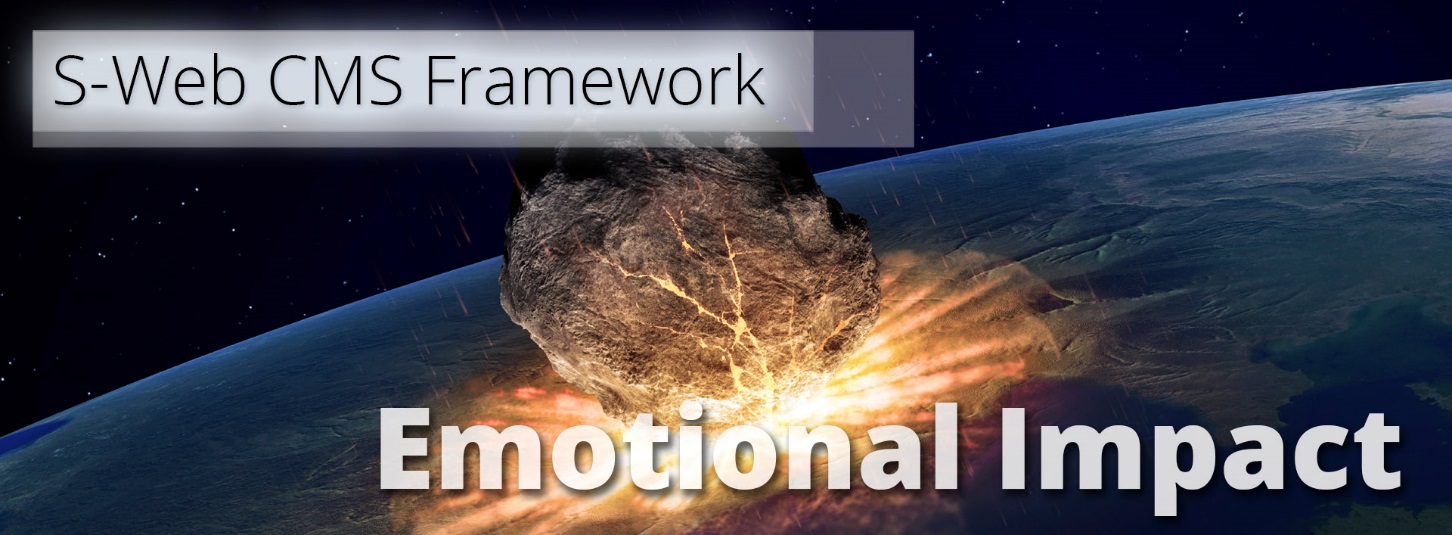
Dixon & Adamson:
Emotional impact is all about making absolutely sure your customer sees themselves in the story you are telling. Now you’ve got to make it personal, this is where story telling really comes into play. As the name implies, emotional impact isn’t about the numbers, it’s about the narrative, you’ve got to paint a picture of how you and other companies, went down a painful path, that the customer will recognize.
Later in this book we present two emotional Impact stories, which for now we shall just touch on, before presenting our ‘Emotional Impact’ narrative that is specifically relative to the S-Web CMS Framework.
1. Key Staff Leaving
In chapter 2 we present an ‘emotional impact’ narrative and solution to the problem of losing one’s best agents who either start their own competing business or join other competing firms, often taking with them one’s database of inventory and client list and always losing the company money.
This story should feel immediately as familiar to estate agencies and rental agencies alike, indeed this is a familiar story in most businesses, which we counter by including key staff as shareholders in one or more of the primary network’s 8 agency websites, or by recruiting staff to the network as individual network/website owners. This not only avoids the temptation to start their own businesses as they already own the business, it also is a primary building block for individuals to reach their potential as everyone works harder when they are running their own business and not working for the man.
In addition, the systems created to assist one staff member to the job of three, including answering the most important enquiries and replying to the most important conversations out of hours assisted by the Ai, are equally good reasons for personnel to stay put, as if they leave, they will no longer have access to the software, and will be less productive.
2. Accounting and Admin Nightmares
In chapter 6. S-World TFS™ (Total Financial Systems) we present a harrowing tale of 8 years of financial inefficiency created by 6 financial managers, accountants, and book keepers who should have known better, but did not. Which lost or cost CapeVillas.com over R6million / $460,000 which was not only a huge amount of money to lose, it was also a huge amount of money that could have been invested into the business to create wins.
This accounting nightmare was centralised around human error and the Pastel financial software, that come rain or shine were completely unfit for purpose.
For this reason, in 2010 after the 5th biggest firm in South Africa ‘BDO’ made a R2million / $150,000 VAT error (not in our favour) and had cost another R2million / $150,000 in billable hours and associated expenses, I decided I simply could not carry on with the status quo and I needed to create our own financial systems. Which alongside the affiliate website idea gained from working with Sotheby’s turned into the first S-World business plan in February 2011, which over the past 6 years has developed into the plans we are presenting right now.
3. Web Developer Frustrations
To refocus this chapter to the S-Web CMS Framework we shall share the frustrations we had with web and database developers, that lead us in 2013 to create our own database first web development team.
But before we begin let’s hear some supporting data from the CIO executive board:
Only 26% of business leaders rate their IT departments as effective.
76% of staff disagreed with the statement: “Their job performance improved due to a new system delivered by IT.”
In 1999 after 10 years working as a Cubase network programmer, like many in my profession I (Nick Ray Ball) swopped to web design and development and became an immediate expert at a new image rich web design system called Flash as it was timeline based and very similar to Cubase. In the year 2000 after attending a lecture by Macromedia on Flash in London, I set myself the goal of making a virtual tour from it. By 2002 I had done so and we were the first company in the world to do so.
During this time, I had emigrated from London to Cape Town and created the web development company ‘Cape Go.’ However, the web was only taking shape in Cape Town and no matter how good our work was, it was difficult to get clients. So, we started developing websites for ourselves and running the business.
In those early days in 2000 to 2003, I created the CapeVillas.com website and others in Dreamweaver (HTML) and Flash, which we were more than competent in. But in 2003 as CapeVillas.com became a success, the need arose to build a database driven CMS (content management suite) for Cape Villas as it was becoming labour intensive making each page individually and updating pricing was also a problem. Fortunately, our first venture into database driven web development was very painless and free, as a local database web development company loved our website and in particular our virtual tours, and offered to add their CMS to our website for free as a portfolio exercise for them.
Soon after we swopped to another company to build further functionality and this was also a smooth process. And by 2005 we had added a property management system and other software components created as part of the CapeVillas.com website. But in about 2007 the company we used split up for some reason, and we needed to find new database developers. We went to the companies we knew had a good reputation, but they pronounced that the PHP code in our website was old and messy and needed to be completely re written and in fact we needed a completely new website.
Whether this was because they were trying to up-sell us, or whether they just weren’t that good I will never know. But it happened more than once, indeed our previous developers had been trying to get us to replace a website with a new one for years. What I do know now is that we never did replace the website, and my current programmers don’t have any problem working with it. Albeit it definitely needs an update from a visual perspective and were gearing up to do that.
Not being able to find a development company who could or would work on CapeVillas.com turned out to be a very expensive lesson, as with no database developers we could not continue to improve the system. And in 2010, when a competitor brought out their version of a property management system for public use, we were no longer the leaders in vacation rental technology, and they forged ahead whilst we did not.
However, this is not the story I am telling… going back to 2009 two years had passed without development. But in those years we created The Cape Villas Magazine and distributed it with Condé Nast Traveler to great acclaim, seeing big brands like Bulgari asking to sponsor the follow up, and two of the estates agents we are currently considering to operate the Villa Secrets ‘primary network’ (Seeff & Sotheby’s) asked us to assist their set up of villa rental departments on a profit share basis.
Regarding Bulgari and the follow up publication, we worked out that we would make better ROI from our publishing and distribution if we opened up our market, instead of luxury villas in Cape Town, luxury properties across Africa which led to the creation of ExperienceAfrica.com. And while we could not develop CapeVillas.com, as it was a new build we found a developer who could create the Experience Africa website the way we wanted. So, we started to create that website and brand.
Our financial manager at the time, who had come to us a year before from a company 20 times our size, has informed me that we would have over R1million / $75,000 in the bank if all debits were paid and all credits received. So, I went ahead with the development of not the website and brand, including a new shop, fixtures and fittings, and a department of 4 very capable personnel, plus a dedicated Flash/graphics based web designer.
Initially, the new website was being developed per my designs and specifications and we spent about 6 months getting it looking really good, but I did not give specifications for the CMS. My thinking was the CapeVillas.com CMS that was created in 1999 worked well, and I just presumed that 10 years on a professional web developer would be able to improve upon it.
Big mistake!
By the time we had done the product research (picked our favourite 50 or so safaris, resorts, honeymoon villas etc), and made the websites UI (User Interphase/what the public see) and opened the new store we started having problems with the CMS. At first I just thought it was teething problems. But as time passed, things did not get better. And every other day another staff member would say that he or she added a property but then it disappeared, or it would show an error signal.
It was such a shame as the design was awesome, and the big pictures and Flash animations at the top of each product’s page made its product pages superior to all competitors. In fact, the design was so good that Sotheby’s Realty Cape Town entered into a profit share venture with us, and for them we created a duplicate version of the website called AfricanConsierge.com. And this was the bright idea that this book is an extension of, a website that could be recreated again and again for many companies on a commission share basis.
But alas, the developers never did fix the bugs and neither our staff or the staff at Sotheby’s could add properties. And as money was getting tight I literally had to scrap the entire brand, let go of all the staff and a year later I scrapped the entire website. Total losses of over R1million when we include the shop and staff.
Was it foolish hiring the staff and shop before the website was live, sure it was. But as far as everyone could see, it was a great website, and I really did not anticipate that a CMS would be such a problem.
As it turned out the problem was not the programmer. It was with the developer who would not let us speak to the programmer, for reasons I put down to him worrying we would offer him (specify which) a job I guess. But without access to the programmer and working through a middle man, who did not really understand the process, made it impossible to fix the bugs in the system.
To make matters worse, the developer eventually worked it out, brought out a competing villas website and teamed up with one of our best sales people to start a rival business, that to this day is still a competitor.
This was not the only incident of this kind. In 2003, we lost our lead developer to a real estate company who had at first asked to work with us. Working under the radar, he quit our company to work for theirs and created a website for them including all the villas we had fought long and hard to identify, that at the time became our biggest competitor and is still competing today.
And again in 2010 our web designer was lured to another company and took with him our entire portfolio of photographs and properties list, and created another rival site, albeit this one never got off the ground.
In conclusion
At the end of 2010 with the continued problem of losing our best staff, the ridiculous and reckless behaviour of accountants and their chosen software that was not fit for purpose. combined with both web developers failing us and/or starting new companies in competition to us; it was time for a change. And so, I retired from the frontline of Cape Villas and decided I needed to go back to my programming and web design roots and create a system that elevated all the problems mentioned so far, that contained a CRM (customer relationship management), financial software and connections to PMSs (property management systems) and GDSs (global distribution systems) all as one system.
In March 2011, the following plan was created initially for VIRGIN
www.s-world.biz/TST/The_Virgin_Business_plan_in_Retrospect.htm, and since that day we have worked it and got better at it. First working out the network strategy and incorporated some highly advanced mathematics to create the ‘big picture’ of how we would like the international network to be, then developing the prototype web CMS framework, then adding the PMSs & GDSs connectivity and a JQueryMobile website. Then turning the whole project on its head working Mobile First. Then turning the project on its head again by creating a WordPress hybrid website. Then removing the WordPress elements and building software straight into the system. Until now we are designing systems that are unique, ahead of their time, and completely disruptive.
A disruptive company is typically a company that spends more time creating a product than its competitors, that is so advanced that it disrupts the market, carving out giant chunks of market share along the way. For example, Facebook, Airbnb or Uber.
Step 5: A New Way
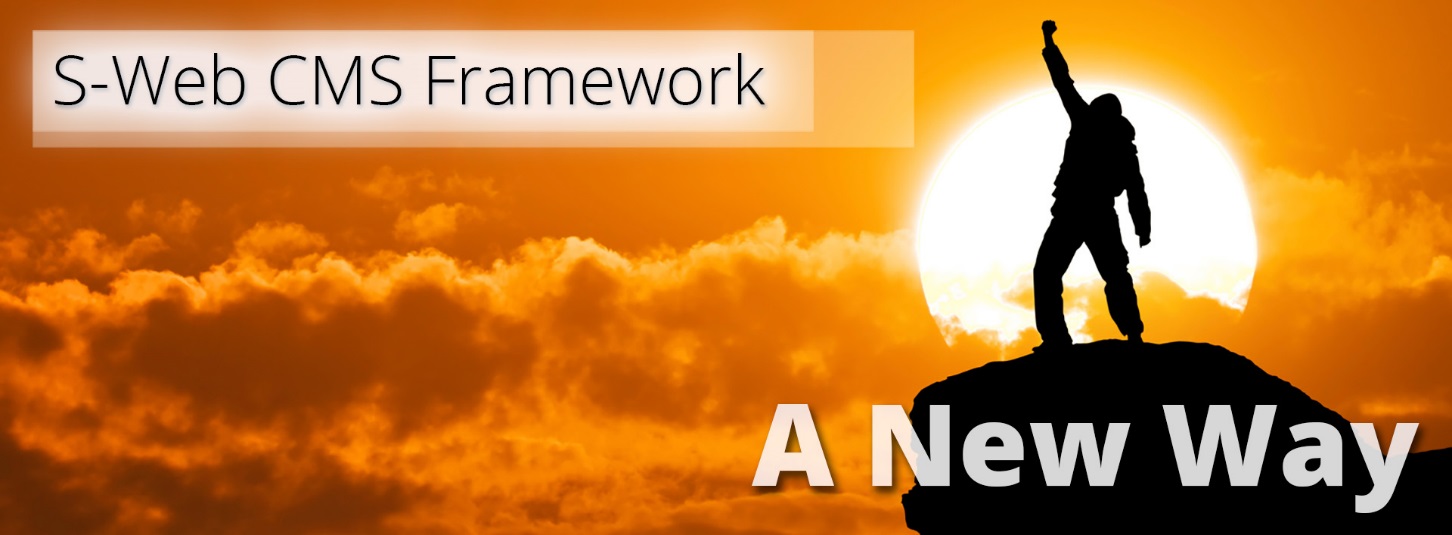
Dixon & Adamson:
Now it’s time to show the customer the solution, a point by point view of the specific capabilities they would need to have to benefit from the opportunity to make money, save money & mitigate risk that you are presenting.
However step 5 is about the solution, not about the supplier. It’s about showing customers how much better their lives would be if they just acted differently. You’re looking for your customer to say something like: ‘You’re right that makes total sense, that’s what we need to do,’ or ‘that’s the kind of company I want us to be.’
So far in this chapter we have identified several problems. We shall begin by looking at them one by one, and add some finer detail before presenting solutions.
- There seems to be no web framework at the scale we are working to that can simply and easily create a complete website, created by people with no knowledge of web design or programming.
- Large custom-built websites often lack ‘Wow & Awe’ and rarely have the design standards of the most cutting-edge WordPress themes
- Most CMS components created for staff use are poorly designed and boring and as neuroscientist John Medina confirms, “When the brain deems something uninteresting it will disengage from it.”
- Websites created initially for desktop have different navigation and functionality to how it would be best to create a mobile website in the first place.
- Smaller web developers who live locally in your place of business can copy your work and create competing business (as what has happened to us on 3 occasions).
- Web development companies can look very good online but perform terribly with CMSs and complex systems.
- Changing web developers can be challenging, as more often than not a new company will want to create a new website. In the same way, they say in building, “it’s cheaper to build a new house than it is to renovate an old one.’ So, it’s easier for developers to create a new site than work with another developer’s code.
- Software created initially for desktops needs a different workflow on mobile or when creating Apps.
- All-purpose multidiscipline software products such as Zoho
The Zoho system provides accounting, a website, a CMS, a CRM & other functions. But other than maybe their accounting, each system is always second best to industry leaders. Their websites are nowhere near the standard of WordPress. They have limited CRM functionality compared to Sales Force and a CMS and workflow that is uninspiring.
For more complex integration, one needs an expert to set it up which can take months and cost $$$$, and connecting to an existing website requires a skilled PHP programmer to make the API.
- Software, Websites, and the problem with APIs
Software products like Sales Force CRM and Sage Accounting need to be connected to a websites database via an API, which requires specialist programming, is complicated, and is the wrong way to run a web-based company.
If your software is primarily there to support your website, then the software should be part of the website. The more APIs one creates for vital data or variables, the harder and more complicated a system becomes.
We shall start with point 10 and work backwards presenting ‘a new way’ for each problem.
Problem 10. Software, Websites, and the problem with APIs
Below we see an ultra-simplified way that one would connect 4 different systems together using APIs.
- A CRM such as Sales Force that improves a sales person’s organization and communications such as E-Mail.
- Financial software such as Sage Accounting, which in this scenario we create as the master accounting tool and so responsible for Price. Although any of these systems could be the master system for price, and that’s what makes it complicated, there is often a choice of many systems that could be the master for one variable or another, instead of one central database, one has four (or more given more separate software systems).
- The website which in this case we are attributing the initial enquiry data to.
- Connections to PMSs (property management systems) that provide availability (the dates).
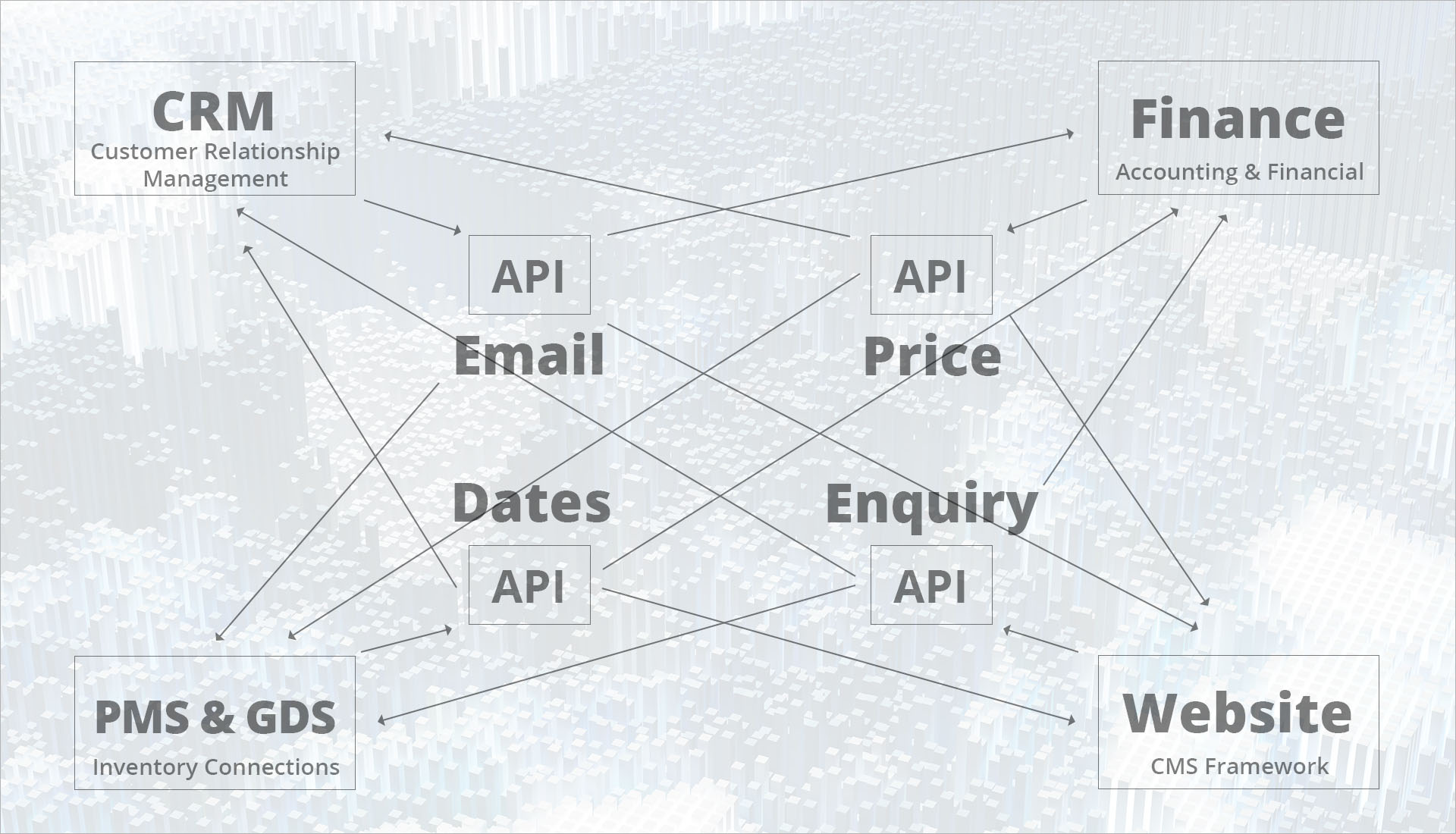
The problem with this picture is that there are many master controllers. If one were to add a new system, say marketing software by Marketo, it would need to fetch data from 4 different sources. And to get the most out of it, all the other systems would need to fetch data from it. The more systems you add, the more different master controllers of different data you have. There is no single place to connect to. Then if you wish to add concierge software such as Gold Key it’s the same problem again, and each time you add another system it creates another layer of problems.
In addition we need to remember we are looking at a very simple view, each system could have 1,000 different functions that all need to be recorded in one database table or another.
Programming in this way is greatly affected by the law of diminishing returns, as the more software and the more functions per software item, the more you add to the complexity and the less efficient it becomes. There is no magic wand. Eventually it will become so complex that development will grind to a halt, as programmers spend most of their days trying to remember where this database table or that database table is, and which API is the master for which functions in the first place. Even the most organised of development teams can only get so far with this method of system architecture.
And of course, there is no way to make this work together on mobile at all. Not in a way that is useful. Instead one would need to swop between the different software apps.
However in 2015, in the early days of the S-Web framework this was the way we were going to create the software, connecting over a dozen different pieces of software, seen here in over 5 hours of video:
http://network.villasecrets.com/business-plan/system-software-framework/divergent-crm-the-future-in-consumer-relationship-management
It’s not that this was a bad solution, it would be an awful lot better than no solution, but its light years away from ‘limited only by our imaginations.’
So what is the solution?
“If your software is primarily to support your website, it needs to be a part of your website, contained within the web framework.”
This solution started to emerge in the Autumn of 2015., As a part of a deal on hiring another senior programmer, I was given an intern programmer for 6 months for free and I experimented with the intern on integrating software directly into our website, specifically the magnificently complex ‘Magic Menus’
http://network.villasecrets.com/business-plan/system-software-framework/magic-menus-intelligent-xml-sitemaps-cms-logic.
Unfortunately in the end we did not use the system, but that’s not the point. The point is to work with an intern with a degree in computer science but no experiences on developing complex software including the multiple APIs needed. I needed a different way to work. I could not just give a list of functions, as that would create code that only he could fathom.
So, I created a new way of working with programmers that I called ‘CMS Logic’ which demanded that for every variable and database input, we would create a new CMS page; which I could use to adjust every action. But more importantly, it reminded me and the programmer where everything was in the first place. Because believe me by the time you have programme hundreds of variables into multiple APIs it gets hard to remember where everything is, and is much harder for a senior programmer to oversee and add to when necessary.
Over time ‘CMS Logic’ developed into the S-Web CMS Framework. At first we improved the basic CMS function of adding a product. Then we thought, let’s do this to the homepage as well. And then we thought to create a CMS for every front-end page for the website, created in a simpler way than any other webpage building CMS we have seen, as instead of web page elements we created the CMS as a finished page and just allowed users to swop text and pictures. Which basically meant that not only could a complete novice at web design create the whole website without assistance, they would do so at least 10 times faster than a trained WordPress or other web designer could.
But we shall get back to this later…
Creating the system per ‘CMS Logic’ enabled us to start to add the pieces of software that we wanted from external systems directly into the S-Web Framework, and the original idea of having many different systems linking to our website via APIs turned into creating the functions we need from the software directly into our CMS Framework.
In the graphic below (which instead of the 4 systems seen in the previous example we see 10 systems), if you compare the graphics you can clearly see the unrivalled simplicity of all systems fetching from just the one database.
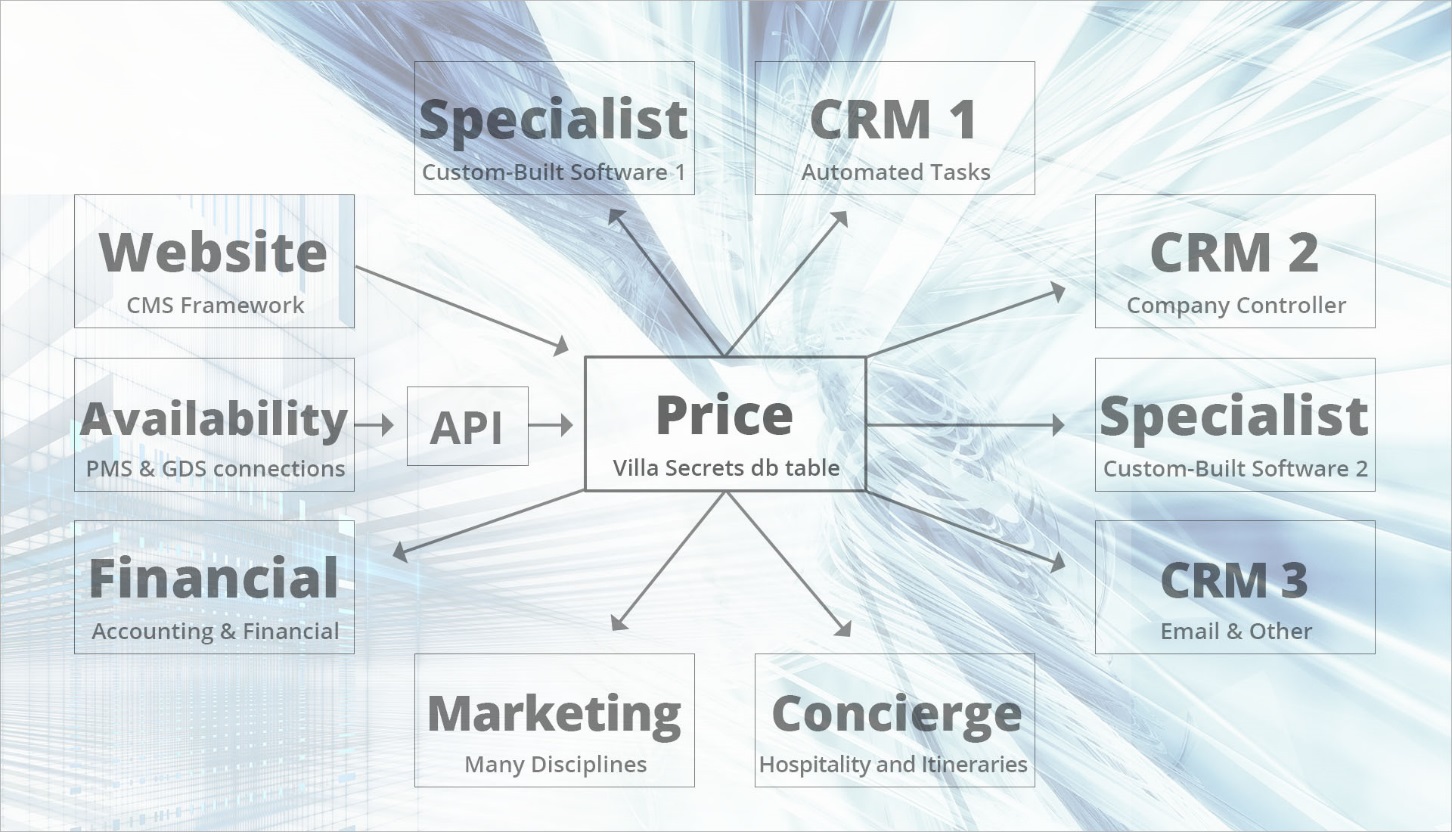
In this scenario, we are highlighting one of the database tables essential to all systems ‘The Price,’ which is created by either the website CMS Framework or the PMS, and all other systems fetch from a single database, or actually 2. But the point is it’s easy to work out where the price is.
Only by working in this way can one create complex systems in a way that challenges the law diminishing returns created from accessing vital data from multiple APIs, as one simply goes to the master database.
And remember what we are seeing above is a very simplified view of just 10 systems and only one variable ‘The Price.’ To imagine the scale of the entire system a quote from Anthony Hopkins in Meet Joe Black comes to mind:
“Multiply it by infinity, and take it to the depth of forever, and you will still have barely a glimpse of what I’m talking about.”
One simply can’t begin to do this with a bunch of different system created by different teams all threaded together by a bunch of APIs.
If one were to be objective however, or play devil’s advocate, one may hear the argument that creating the software from scratch like Sales Force needs tens or even hundreds of millions of dollars in R&D funding, and anything less would not be to the same standard. This assumption would be correct if one tried to make a CRM for everyone and every industry.
But as we are going industry by industry, we don’t need to recreate Sales Force. We only need CRM elements that are suitable for running a vacation rentals company. And in fact, because we are only focusing on this as a starting point, we can build a far superior CRM to Sales Force (suited to a specific industry niche) for a fraction of the price. As is explained soon in ‘Our Solution’ and in chapter 14. S-World TBS™ (Total Business Systems):
Problem 9. All-purpose multidiscipline software products such as Zoho
The Zoho system provides accounting, a website, a CMS, a CRM & other functions. But other than maybe their accounting, each system is always second best to industry leaders. Their websites are nowhere near the standard of WordPress. They have limited CRM functionality compared to Sales Force, and a CMS and workflow that is uninspiring.
For more complex integration one needs an expert to set it up, which can take months and cost $$$$, and connecting to an existing website requires a skilled PHP programmer to make the API.
Solution: The Solution to the above is exactly the same as the solution to the last two points. One needed to create the software as a part of the web framework not as separate items, but with added emphasis on each system individually needing to be either equal to the next best thing or better than it, for the specific industry niche it has been created for.
Problem 8. Software created initially for desktops needs a different workflow on mobile or when creating Apps.
Solution: This one is simple. Don’t start with a design for desktop, start with a design for mobile then adapt the desktop to the mobile (this is known as ‘Mobile First’ design).
But note, as all the current market leaders created their products before being seen on mobile was an important factor, each was initially created as a desktop device, which is why a system created first for mobile if done excellently will always beat a system first considered for desktop users, when it comes to delivering the most efficient, fun, and addictive mobile experience.
Problem 7. Changing web developers can be challenging, more often than not a new company will want to create a new website.
In the same way, they say in building, “it’s cheaper to build a new house than it is to renovate an old one.” So, it’s easier for developers to create a new site than work with another developer’s code.
Solution: Don’t hire developers or use development companies, be part of a disruptive technology company and pay a reasonable 2.5% royalty for their continued support and development.
Problem 6. Web development companies can look very good online but perform terribly with CMSs and complex systems.
Solution: Make sure you see an example of a CMS or complex system created by a developer before trusting them. With the best will in the world, nowadays, it’s very simple to make a great looking WordPress website, but when it comes to creating custom CMSs and software it’s a totally different ball game.
Problem 5. Smaller web developers who live locally in your place of business can copy your work and create competing business (as what has happened to us on 3 occasions)
Solution: One can incentivise developers with equity or profit share, or one can outsource development to India, the Philippines, or Eastern Europe to get access to ‘pound for pound,’ much better programmers and developers who are much more work focused. Alternatively, just work with a big and respected firm with a portfolio of work that is equal to your ambitions.
Problem 4. Websites created initially for desktop have different navigation and functionality to how it would be best to create a mobile website in the first place
Solution: Same as point 9, work ‘Mobile First.’
Or create a separate App entirely and work backwards from the App design to create it on mobile.
Problem 3. Most CMS components created for staff use are poorly designed and boring and as neuroscientist John Medina confirms, “When the brain deems something uninteresting it will disengage from it.”
Solution: Demand more from your web or software developers, ask that they treat the back-end systems of your website with the same level of design and functionality as front-end systems. One will be surprised just how far and how much you can do with a CMS if one treats it with the same respect given to the homepage.
Problem 2. Large custom-built websites often lack ‘Wow & Awe’ and rarely have the design standards of the most cutting-edge WordPress themes
Solution: Again, demand more from web designers and developers, there is nothing that can be created in WordPress that can’t be created and improved upon in a custom web framework. Although It may take a couple of years to get it right.
Alternately, again go with a respected large web development firm who within their online portfolio has a website just like you want, who can show you a working CMS and can reassure you about their ability to create software within the website. But be prepared for a plus $1million starting price for a project anywhere near what we are presenting.
However, by far the most practical solution and definitely the most economical is to take all that is ‘wow & awe’ about the most up to date cutting-edge WordPress designs and recraft it into a web framework, that one can use again and again, creating each time a website with the looks, or even better looks than WordPress, but within a framework that is custom-built for the task, that can add software straight into the core of the system.
Problem 1. There seems to be no web framework at the scale we are working to that can simply and easily create a complete website, created by people with no knowledge of web design or programming.
Solution: One would need a completely different way of creating websites. Instead of working like WordPress where one has a theme which one can customize, adding this widget and that widget to make up a page, and then adding complex plugins such as the Advanced Layer Slider seen here at the top of the page from our WordPress blog: http://blog.villasecrets.com/blog/stefan-antoni-cape-town-villas-in-south-africa
Instead one needs to really simplify the process, for a start, the idea of adding various elements, widgets and plugins to a page has got to be thrown out the window. And in their place, instead just present the user with a page that is already complete. And simply get them to swop the text and pictures.
It’s that simple.
Of course, it not as versatile as WordPress, it does not have thousands of different themes, not yet. But this is part of the simplicity, not 10,000 themes, just a few for now. But so what if your theme is better than most or all competitors, is a dream on mobile, and has all the connectivity advantages presented earlier enabling the simple creation of complex and original software… who cares.
I’m reminded of a quote from Chris Cox, the Facebook Chief Product Officer:
“We built a product that boiled down and removed all of those features, except for one thing, which was tagging it! So we organised the photos on the web around people, and it completely changed the experience, “That was (click) just like that!”
It’s the same principle. You don’t need all that so why make it a part of the framework. For non-designers, one only needs to see complete pages then add or swop the content, then it’s simple, and not only can it be done by just about anyone, it can be done 10 times faster.
For instance, to create a website not for a vacation rental or estate agency but for a single property. If one already had the text and photos prepared, one could create a complete beautiful 20-page website for a stand-alone villa in less than an hour.
Try asking any WordPress developer how much of a website they could create in an hour?
And this point comes full circle to our mandate marketing initiative and why few can copy it. As for it to be effective one must make every dollar count, and spending $$$$ on this website and paying god knows how much to design Coffee Table Books and other marketing systems we have created would just burn up the money in no time at all.
To win in mandate and prestige marketing, you need to make your bucks count more than double, and this is just one of the many advantages of thinking simple, clever, different, and always disruptive.
The Villas Secrets’ Secret
BUSINESS PLAN
& OPERATIONS MANUAL
Chapter 1
The Challenger Sale Step 6: ‘Our Solution’
The Challenger Sale Step 7: ‘Our Product’
The S-Web CMS & Software Framework
The Challenger Sale Step 6. ‘Our solution’
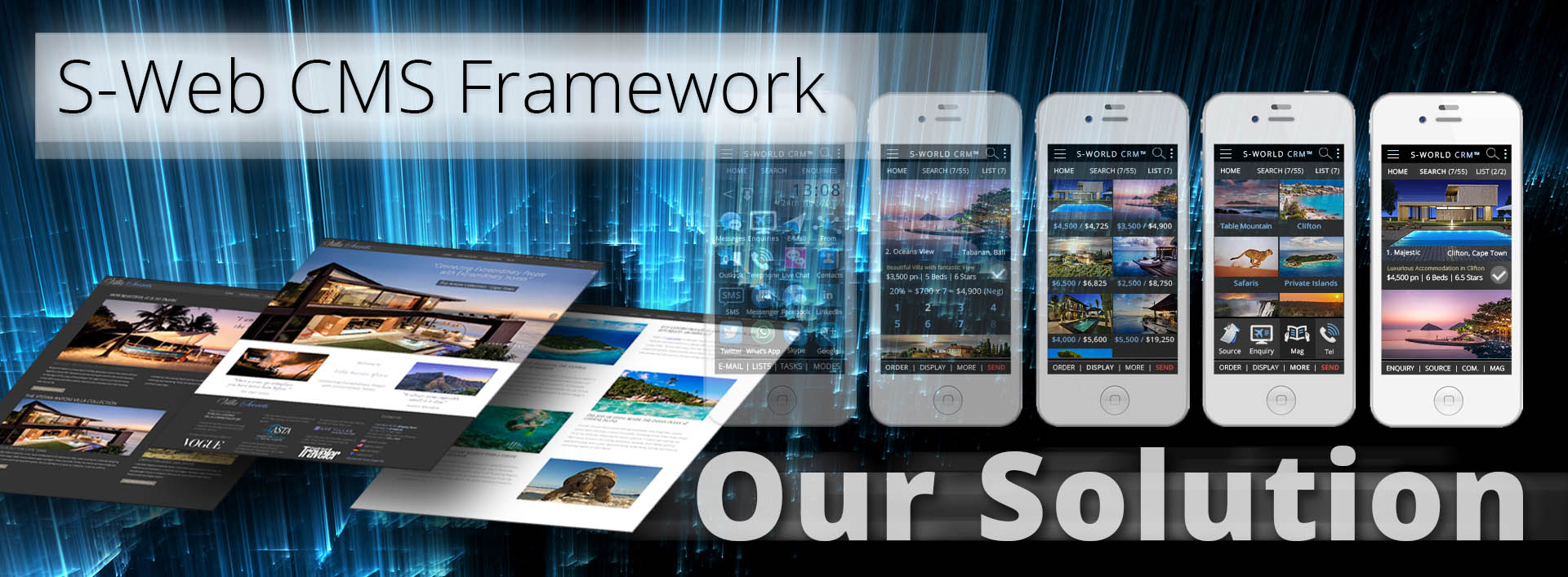
Dixon & Adamson (The Challenger Sale):
Finally, demonstrate how your solution is the best one out there, now you lay out the specific ways that you can deliver the solution better than anyone else.
- S-Web CMS Framework Part 1
a. A Combined Website and Software Framework
b. We work one industry niche at a time
c. We work ‘Mobile First’ - S-Web CMS Framework Part 2 (90% Complete)
a. S-Web Super Simple CMS
b. S-Web Mobile
c. S-Web ‘Out the Box’ Complete Website Builder - S-Web CMS Framework Part 3 (75% complete)
a. S-Web CDS™ – Content Delivery System
b. S-Web CDS™ – Online Magazine and Printed Media Publishing
c. S-Web CDS™ – My List / My Webpage
d. The Villas Cloud – Online Availability & Bookings
e. S-World CRM-Ai™ – Bookings and Sales Ai (The Raybot) - S-Web CMS Framework Part 4 (In the development que)
a. S-World TFS™ – Total Financial System
b. S-World CRM CC™ – Company Controller & The Hawthorne Effect
c. S-World UCS™ – Competitive Games, Fun and Addictiveness - S-Web CMS Framework Part 5 (Effectiveness of all system)
a. S-World TBS™ – Total Business Systems
S-Web CMS Framework Part 1
a. A Combined Website and Software Framework
“To create truly disruptive complex systems without creating overly complicated systems; if your software is primarily to support business gained from your website, your software should be part of your website contained within a single web framework.”
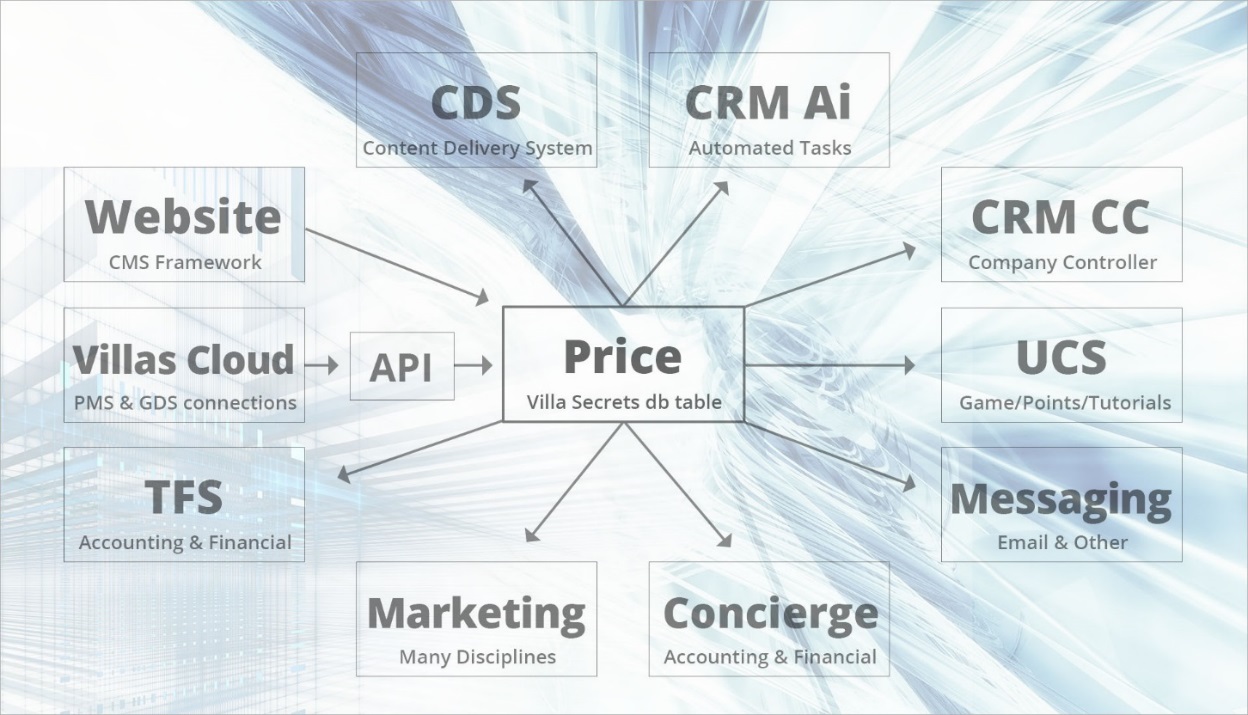
Above we see a graphic with 9 different Villa Secrets software systems intrinsically connected to the CMS web framework (the Website). On which we have isolated a single dataset the ‘Price.’ We can see how much simpler it is to develop this system, relative to using many software components strung together by APIs (data connections between 2 or more separate software items or websites) that create multiple data sources. And as seen below, in which we only show 3 software items which are already more complicated.
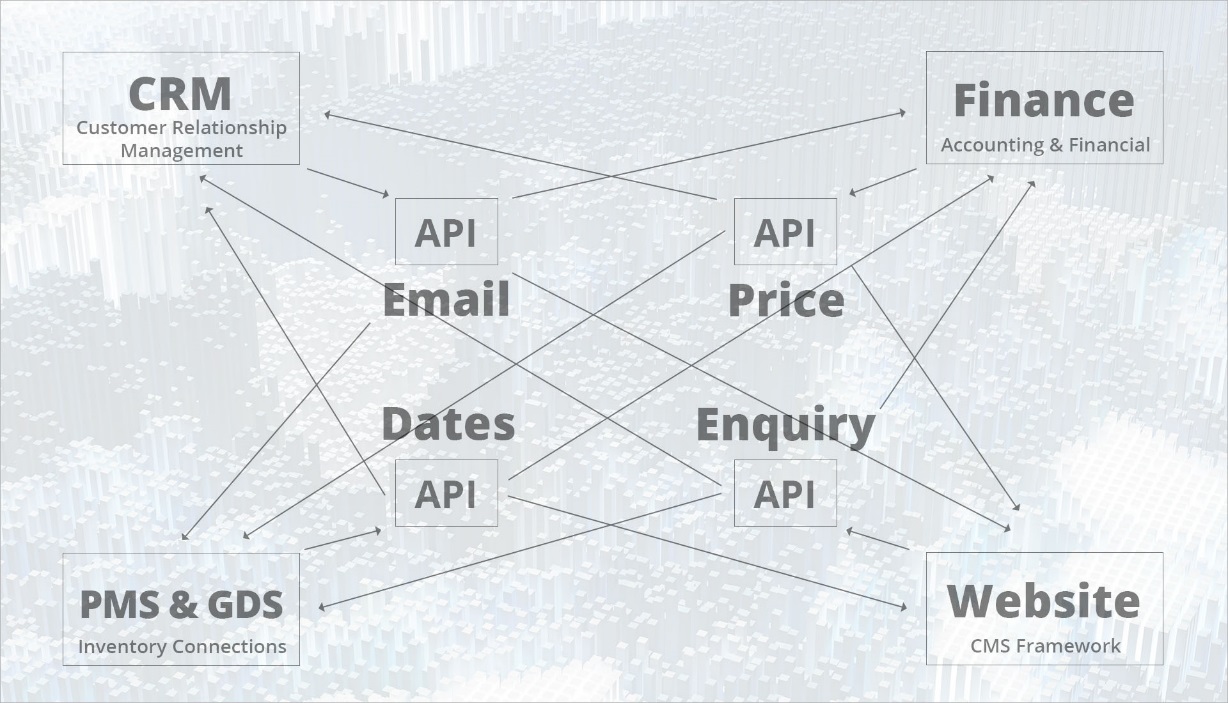
Of course, the above is an incredibly over simplified version of both systems, as there are thousands of different database tables for this function and that function. A company that really knew their stuff could take every possible data set from each API and add that to one single master database. But that’s a lot of organization and time and even then, one is limited to only data sets that are available from the API in the first place.
Whilst very technical the above helps to explain the trouble IT companies have in creating useful systems, which helps explain the statistics from the Corporate Executive Board’s Sales Executive Council. Who, if we remember, serve more than 200,000 business leaders across roughly 4,800 organizations in more than 50 countries and who say:
The CIO Executive Board found that only 26% of business leaders rated their IT departments as effective.
76% of staff disagreed with the statement: “Has their job performance improved due to a new system delivered by IT.”
However, working our way (The Villa Secrets S-Web and S-World way) makes the creation of truly complex systems possible, without being truly complicated. If one has one central database that all systems fetch data from, we avoid the law of diminishing returns that would grind systems made up from different items of software to a halt as they become massive.
This does not mean that we don’t use APIs (data connections between 2 systems), for instance Google Analytics and just about every PMS (property management system) and GDS (global distribution systems). However, for all functions that provide data that we could not have gotten or created ourselves, such as CRM data (customer relationship management), accounting data, marketing, hospitality & concierge software; we create the systems we need straight into our core system, the S-Web Framework.
S-Web CMS Framework Part 1
b. We work one industry niche at a time
Large scale CRMs (customer relationship management) such as Sales Force are not dissimilar to jigsaw puzzles with thousands of pieces, of which some pieces are connected to create a solution. For most CRMs, the name ‘customer relationship’ takes a second place to the sales process of selling to the customer and monitoring of the sales person by management to make sure they are selling to the customer; with the only ‘customer relationship’ function being to send a bunch of follow up emails that most customers would prefer not to receive in the first place.
In contrast, if we go back to the first S-World integrated software design in 2011 created as an investment option for VIRGIN www.s-world.biz/TST/The_Virgin_Business_plan_in_Retrospect.htm, we see that one of our CMSs primary purposes is to deliver gifts to clients. A system now supported by the Villa Secrets Coffee Table Book which will barter product placements and adverts from leading luxury brands like Bulgari for gifts (such as handbags, perfume and other items) that we give to clients on arrival and send to them on special occasions such as anniversaries and Christmas after their stay, providing a truly effective form of remarketing and customer retention.
However, CMS or Sales Tool:
“We make our websites and software for one industry niche, whereas most CRM’s create a product for every business on the planet!”
Ask the C-Suite managers, or any developer at Sales Force, Sage, Zoho or any popular CRM if they thought they could make a better version of their software. If they made a system for a specific industry, or better still a niche within an industry and they would all say…
“Well of course…”
Its far, far simpler to create a CRM specifically for an industry niche than it is to create a system for all possible businesses. Not only because in doing so one can throw away most of the clutter, but because one is making a system specifically for a single purpose that one can get very detailed in the psychology and neuroscience of the communications back and forth.
For instance, we can include items that are not included in all industry CRMs such as 2nd and 3rd level questions and prompts, which in ‘The Science of Selling’ David Hoffeld explains are a key way to influence a potential client to book or buy, as Hoffeld reveals:
“These powerful questions have been analysed in numerous recent scientific studies. For instance, a study at Harvard University revealed that answering second level questions, which prompted participants to state their opinions, increased neural activity in the areas of the brain associated with reward and pleasure! These good feelings caused a change in the brain that naturally enhanced the participants emotional state. In other words, customers enjoy answering second level questions.”
S-Web CMS Framework Part 1
c. We work, ‘Mobile First’
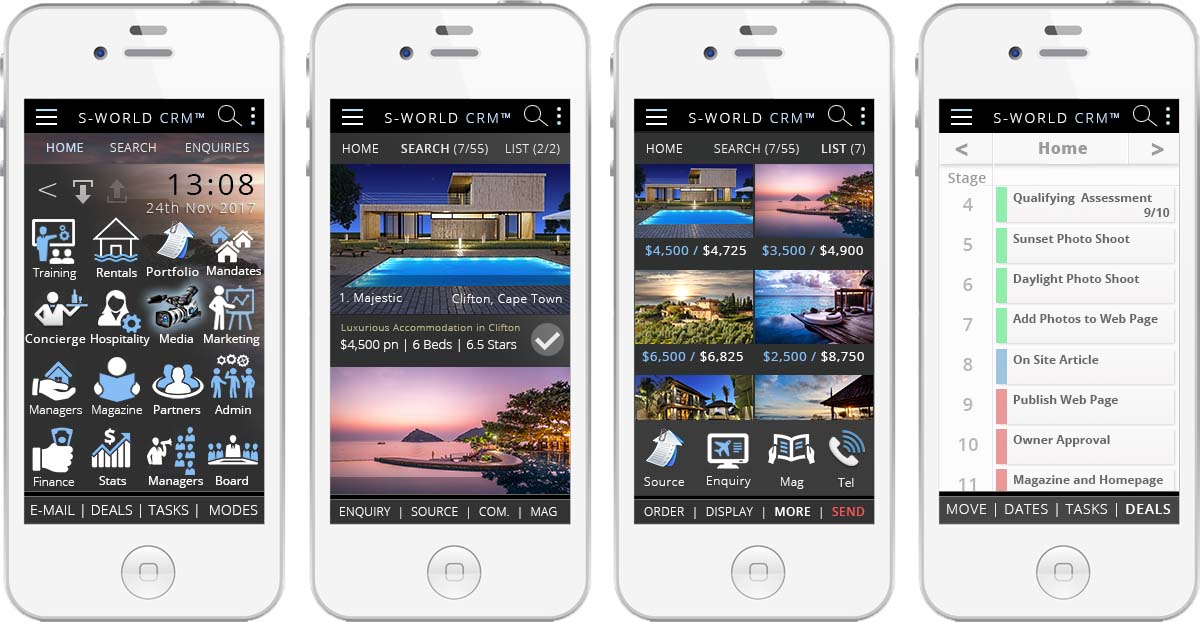
In the spring of 2015, we added a JQueryMobile website to the then prototype Villa Secrets website. You can see the mobile version here http://m.villasecrets.com (please view on mobile, and note its only 80% complete). The reason we did not complete it was that in our ambition to create an ‘out the box’ web product, working this way made life twice as hard as we effectively needed to create 2 websites. So, if we wanted to create 64 versions of the Villa Secrets web framework, each on a different domain, we would need to create 128 different websites.
In addition, we saw warnings from Google explaining that working in this way was not good for them, as with two webpages for each page (http://m.villasecrets.com and https://www.villasecrets.com) and a link to a page on desktop would give no power to the mobile version and vice versa. Another reason we stopped working this way is because each time we made a new page for desktop, we needed to make a new page for mobile. And as we wanted to add many different pages, we could see there would be a lot of work to do, and it would be better if we created our own mobile framework and work ‘Mobile First.’ And in doing so we own our own framework and sow the seeds for a product that can be created instantly at the touch of a button.
So we decided to work from the JQueryMobile design and completely recreate the desktop version, which was a brave decision as we knew it would take at least a year to create, and so we would lose a year’s revenue. But knowing this was the right decision, we decided to gamble all the additional money created from the www.cape-town-luxury-villas.com prototype. And so, at the beginning of Autumn 2015 we added 2 more programmers, a top-level HTML 5 designer and a copywriter.
However, within just a few days of the new team starting, a long term back injury reoccurred and limited my ability to type instructions for the team, who I communicated to from London to India via Skype. This event demanded a change from the development plan and was very significant; and also, rather odd that as soon as I made the change, my back got better and has not troubled me since…
This game changing decision was to learn WordPress, which I had seen catching up and beating my stable tool for web design since 2000 ‘Adobe Dreamweaver.’
Without the ability to communicate at pace with my team, I suggested that we stop the plans I had made for us all and instead we were to all learn WordPress (well all of us but the designer who already knew it).
Fortunately, the very first WordPress lesson I found online was a very detailed three-hour tutorial presentation by Ferdy Korpershoek on the Enfold Theme. Here is Fredy’s video https://www.youtube.com/watch?v=tpMof6O1QNw and here are various demos of the theme
http://www.kriesi.at/themes/enfold/. And as you look you will see how this WordPress theme helped mould the look of our current website design, www.villasecrets.com and in particular the HTML5 animations.
After a few days, my back was better, but having seen the design power of WordPress we just carried on, making various test websites, and testing the database capabilities before integrating an Enfold Theme WordPress website into the Villa Secrets website as a separate blog site http://blog.villasecrets.com. And so, for a while we just experimented with WordPress and the idea of a hybrid WordPress vs Villa Secrets framework website, until we came across the problems mentioned in the previous steps, and in particular that we could not easily add data from our MySQL database to the WordPress SQL database, without creating specialist WordPress plugin each time, which would take a long time, indeed we would need a dedicated full time programmer just to make the plugins.
It was at this point that the decision to completely remake the desktop design came about. And as we were redesigning the entire website, why not do it in a mobile first way? The first task was the navigation which required fewer options, and once created we proceed to make the mobile pages and desktop pages at the same time, using both our WordPress experiments and the JQueryMobile site as a guide. And 21 months later we can see the mobile first Villa Secrets website www.villasecrets.com.
But this is only half the story, because having seen the merits of mobile first web design, when it came time to create the designs for the CMR and other software, we again started with the idea created in desktop, but then designed first for mobile, and in particular the navigation and work flows.
For a truly disruptive mobile experience, we needed the mobile version of the CRM to have the simplicity of a game or a well created APP. So before considering any on page input, we needed to create a simple navigation system.
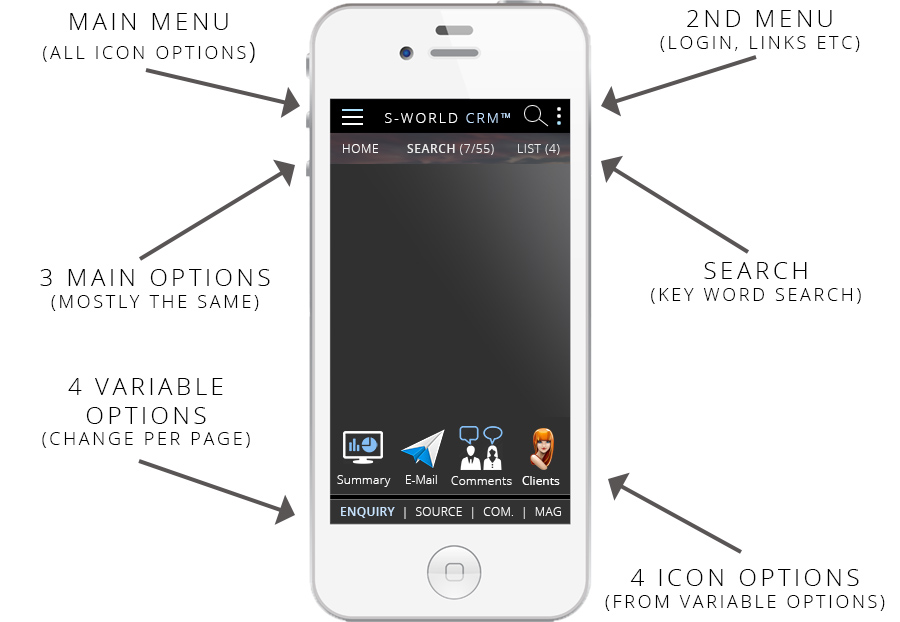
Above we see within our mobile menu, we added top and bottom navigation. The top will mostly stay the same but the bottom will change for each function, and is supported by 4 icons that also change. This creates a total of 48 different ‘quick tap’ options available for each individual function. Which is a lot, and is as far as we know a unique way to navigate on Mobile, because with 48 quick tap options that are instinctively arranged, one creates a very versatile base from which to create complex websites, software, games, and apps.
S-Web CMS Framework Part 2 (90% Complete)
a. S-Web Super Simple CMS

There are millions of companies making ‘do it yourself websites’ but the S-Web framework is different. Instead of making individual pages, S-Web users start with a complete website for users to replace or update the content on each page, with no widgets or fuss. An example of this is our homepage www.villasecrets.com, which can take less than 10 minutes to create.
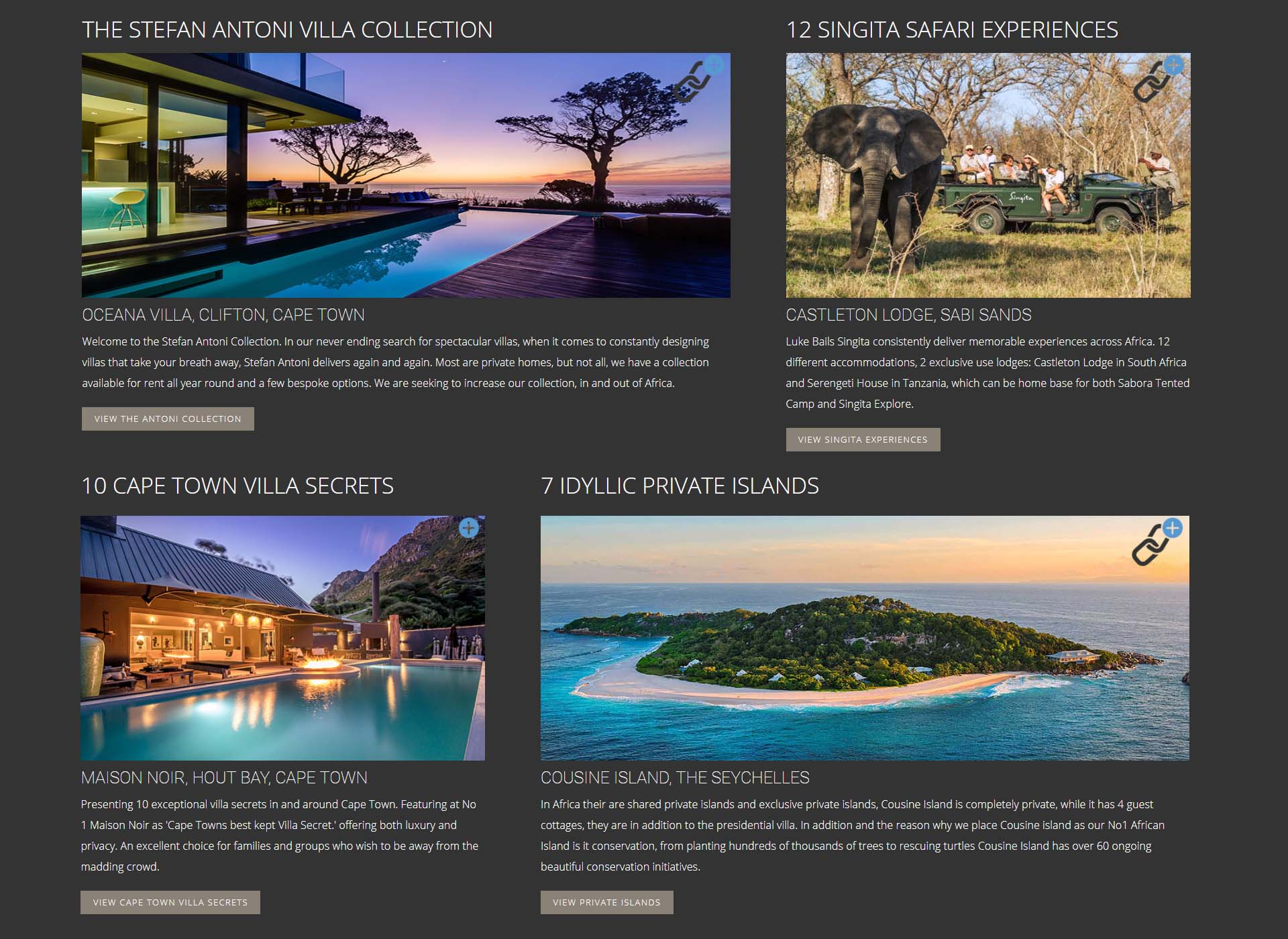
Above we see part of the homepage CMS, which for anyone who has ever used WordPress or other CMSs will look very unfamiliar. There are no options to consider other than the content, and the little link icon at the top right of every picture.
Clicking on this link lets you add the property or magazine article ID. And when entered, it changes all the entire section adding a new header, photo, location, 60-word description and the call to action button, ‘just like that!’
Or one can add a new photo and write one’s own header and descriptions for each part, or simply edit any section.
It’s that’s simple!
And because it’s that simple, one no longer needs a web designer at all, beautiful complex pages can be created by the most junior of staff. In fact, you could even ask your 7-year-old child to create a home page that would still look professional and engage the public.
Skipping back in time a little, our individual villa pages which paved the way to the homepage CMS, were initially forged as a response to web developers across the world raising their game and creating increasing more attractive websites. The only way to combat this was to raise our game, substantially. One idea was to create individual villa pages that looked like homepages, and working in WordPress we created pages like this: http://blog.villasecrets.com/blog/cousine-island-villas-seychelles.
Whilst this and the other individual product/villa pages we made were a great improvement on any other travel or real estate website we could find, and proved very popular with guests and villa owners; each page took about three to four days to create, and as such were expensive. So, we created a super-fast CMS (content management system) for our copywriter and photographer to use. And in so doing after they had written the copy and chosen the images, adding the content and creating the animated image slider at the top of the page was down to a dozen or so minutes.
Here is an example www.villasecrets.com/Villa/North-Island-Villa=6061 which is superior to our original WordPress designs, and better than the most websites homepages. Which makes an impact in the high-end villas market as looks count, both for clients looking to go on holiday and equally the owners and managers of the villas, safaris & private islands.
The final essential component to any website is how one presents products/villas after a search is performed. One can see our search results page here: www.villasecrets.com/Best-Of-Africa, this page gets created automatically via the photos and text in the product pages, and a CMS page that changes the order of the villas.
We are creating a ‘super simple’ ‘on page’ CMS for every page. In fact, most pages are already done, we just need to do the contact us and various ‘about’ pages. Then after, as we add new pages such as Owner & Property Managers pages or the Client Suite, we will create the page and CMS together.
Does it work in mobile? Yes, beautifully and in fact better than both our original JQueryMobile and our WordPress mobile webpages, which got confused by the magazine style layout and ended up showing the pictures in the wrong order. Which yes, could have been fixed in the CSS editor, but not by anyone who was not skilled at CSS coding.
S-Web CMS Framework Part 2
b. S-Web’s Villa Secrets Mobile
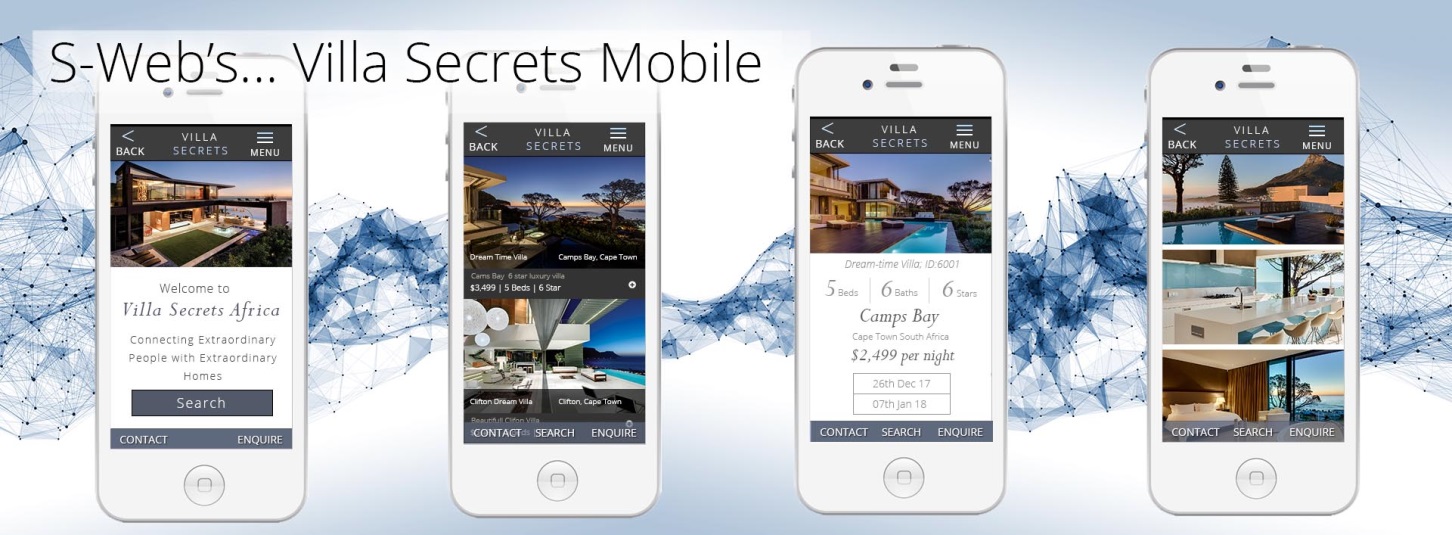
S-Web Mobile, the mobile website that looks and behaves like an App.
When it comes to the best website design, with so many different designs there is no clear winner. However, in the land of mobile websites there is far less competition, we are positioned amongst the best in the world.
There are many mobile-friendly sites made from WordPress. But WordPress is a tool for making smaller websites and not practical for big database driven CMS projects.
Google have warned that they will penalize websites that are not mobile-friendly. It’s only a matter of time until they do, because presenting poor mobile pages create a bad user experience.
Search engines aside, mobile usage has overtaken desktop. To have a site with a poor mobile presence is to say goodbye to half of one’s customers. Mobile is not the future of the web, it is the right now!
As you can see our mobile product looks like an App and has instinctive navigation. It does not have all the functionality of the desktop version, instead, we have taken only the parts that make sense to see on a mobile, as we seek to make both the simplest and most attractive mobile real estate and travel user experience.
But note the only reason we can do this so effectively is because we worked ‘Mobile First’ from our JQueryMobile site, to our desktop site and then created our mobile site responsively from the webpage. Note in particular the on-page drop down navigation that is the same on both desktop and mobile.
Whilst the mobile page and the desktop pages look different, they are both the same page, which in SEO (search engine optimization) is an improvement on mobile frameworks like JQueryMobile. Which demand the creation of new websites specifically for mobile use, which loses any link power attributed to the original desktop page in mobile searches (or vice versa).
S-Web CMS Framework Part 2
c. S-Web ‘Out the Box’ Complete Website Builder
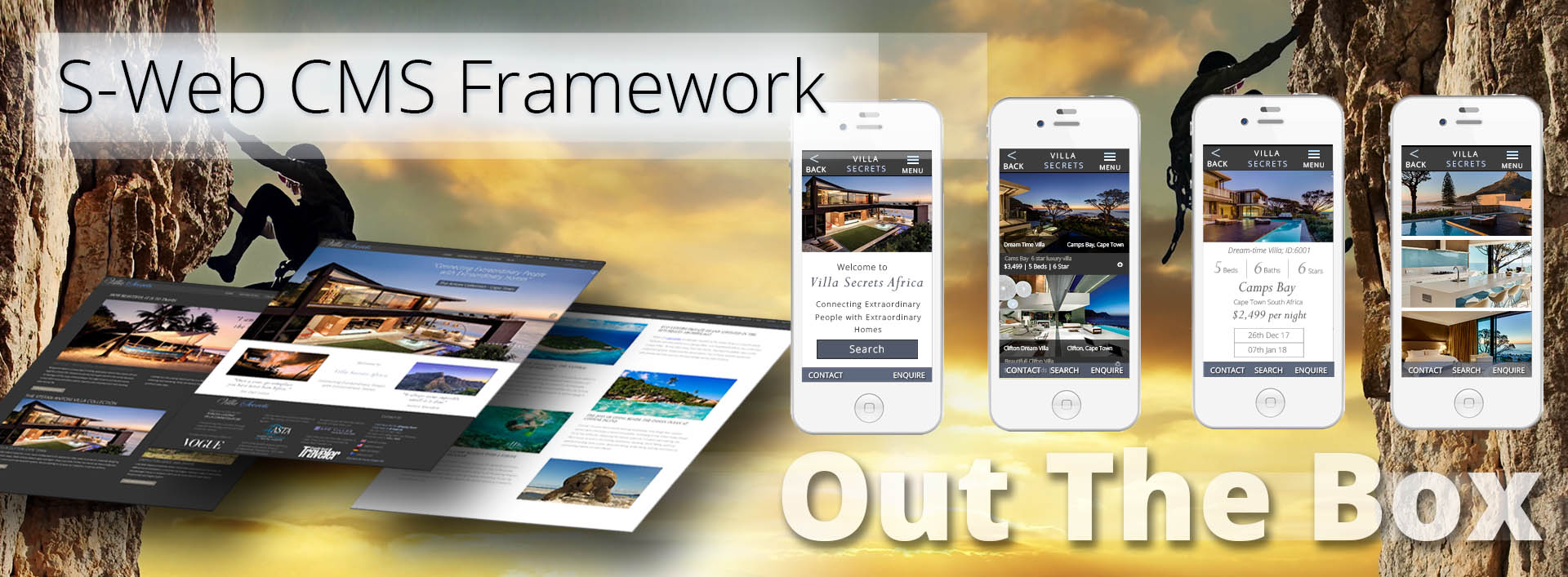
Before we begin explaining what we want to achieve, a word to say we are not there yet. The CMS is complete so each page can be created per the previous points, and in the forthcoming section S-Web CDS™ we show how we can already create users’ individual customised web pages for their own use at the touch of a button. But in terms of a complete out the box website, we can’t yet create one at the touch of a button.
However, what we can do is create batches of websites. We will see in chapter 2 that we have 200 web domains ready. And in 2018 we will create an S-Web website for each, and then present each website as an ‘out the box solution’ to various partners around the world.
However, it is our objective to be able to create a user website as simply as buying a domain name and off they go. This is not an objective that we are looking to achieve on our own in 2018, rather just plan to move closer two it.
However, should Facebook or Microsoft (well actually the Chan Zuckerberg, Paul G Allen, and Gates Foundations) pay interest in our project and secure the 50% of Villa Secrets Ltd. (the holding company) that is currently reserved for them, this is one of the first things we would ask them to do.
And we would not just do this for Villa Secrets, instead, we would create S-Web.org and versions of S-Web for everyday use for everyone, with the extra hook being that we would not charge for it and we would give free hosting. So, literally the cost of creating a great website was just the cost of the domain at about 10 US dollars a year, for a product that is far simpler than any other and looks better than most.
Where we get paid is if people use their S-Web sites for business, and in which case we would ask for a royalty that will go straight to Angel Theory special projects.
The biggest win comes from complex sites that wished to use database inventory, such as Villa Secrets one can only use databases that are connected to S-Web from which a royalty will be collected, in the same way it is for Villa Secrets of about 2.5% of each trade. And in the Facebook and LinkedIn worlds of billions of users, steering those uses to use S-Web for their e-commerce needs and receiving a 2.5% royalty is a very big deal indeed.
What’s to stop Facebook and Microsoft just doing this themselves?
This is the question I have heard from literally everyone I have discussed this with. For sure they have the technical skills, that’s why we’re going there ourselves. However, the reason (I hope) they would choose not to do this themselves lies in the subject of the next book in the Angel Theory series: ‘M-Systems.’
M-Systems is an ecological and philanthropic super project, on a scale much bigger than anyone has ever imagined. It is the macroeconomic plan to Villa Secrets microeconomic plan, and whilst on the surface they may seem very different, they are in fact two sides of the same coin.
To put a scale to it, consider the statistic quoted from the Sales Executive Council, who if we remember serve 200,000 businesses: “When you put it all together, only 14% of companies so called unique benefits were perceived by customers as both unique and beneficial.”
With 22 chapters of unique and beneficial systems, Villa Secrets systems can be argued to be statistically 154 times more unique and useful than the average business.
But here’s the thing, S-World Villa Secrets is only the first of 16 M-Systems, each as powerful and some more so. And as such, if we follow the math, the M-Systems design is statistically over 1000 times more unique and useful than the average business.
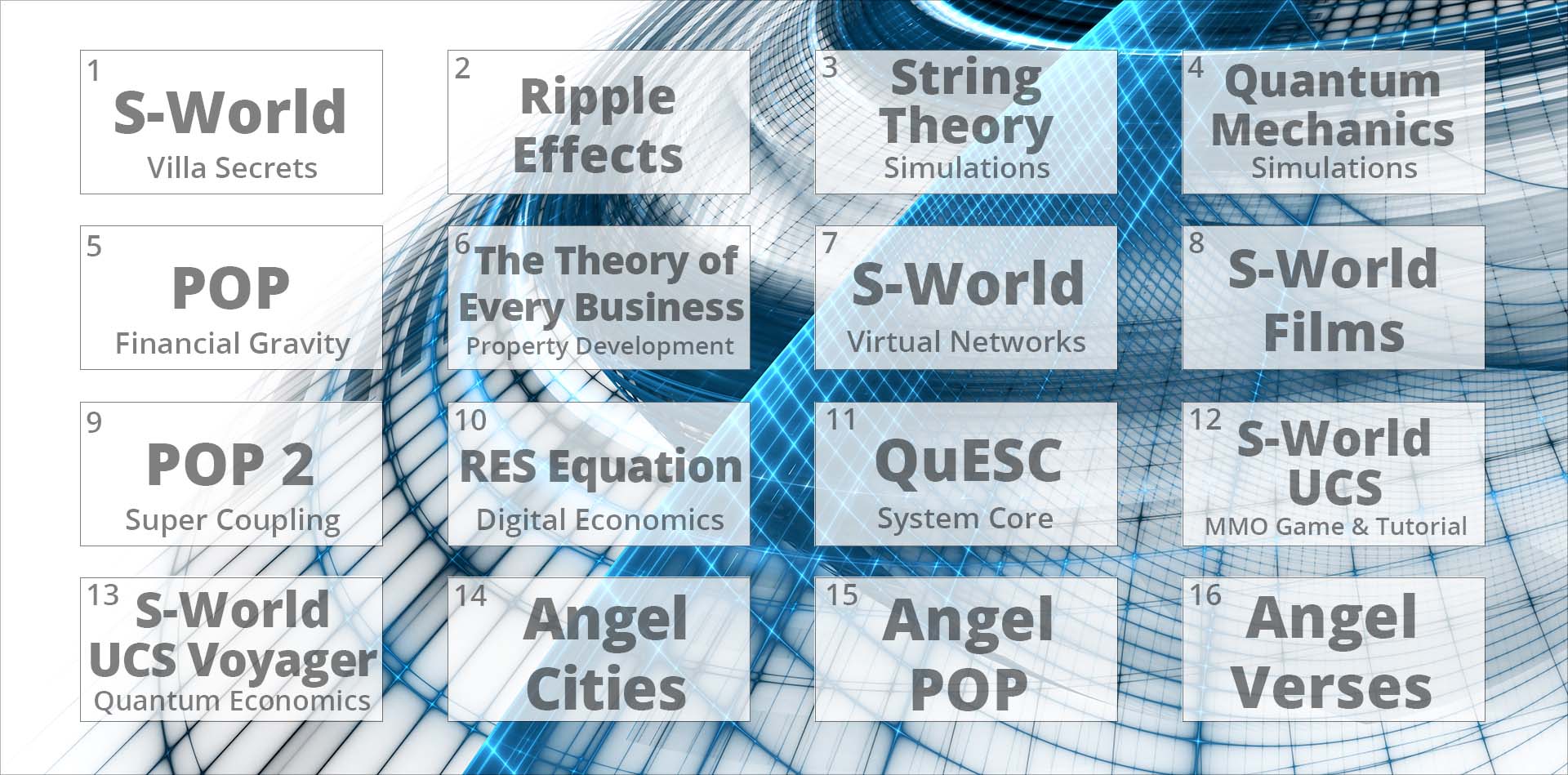
Within these systems lies that answer to why Facebook and Microsoft or others would not just ‘do it anyway,’ as their founders are not primarily interested in making money. Mark Zuckerberg (Co-Founder of Facebook) has pledged 99% of his fortune to improving the world and in particular ‘advancing human potential and promoting equal opportunity.’
Paul G Allen (Co-Founder of Microsoft) says, ‘The possible is constantly being redefined and I care deeply about helping humanity move forward.’ Allen has a passion for Ripple Effects and Elephants, as is the subject of M-System 2, an extension to our 2012 www.AmericanButterfly.org on economic butterfly effects which became the forerunner to both Villa Secrets & M-Systems
Last but by no means least is Bill Gates, (Co-Founder of Microsoft). We can trace the beginning of Villa Secrets, Angel Theory, and M-Systems to the Bill & Melinda Gates Foundation in early 2011 as the inspiration for what was called ‘Give Half Back.’ In which we would create a system that was more than twice as profitable as others and so could afford to ‘Give Half Back’ without the participants being worse off for it, and indeed better off for it, due to the positive PR and branding associated with the charitable giving.
It is the Angel Theory assumption that Zuckerberg, Allen, Gates, and many others are more concerned about how they can help humanity and our planet than any other pastime. And if M-Systems can deliver on its ambitions, we sincerely hope that Zuckerberg, Allen, Gates, and others will jump on board; add to, own, and improve the system by taking their equity in with Villa Secrets and S-Web.org and becoming trusties of S-World (The Sienna Foundation).
S-Web CMS Framework Part 3 (75% Complete)
S-Web CDS, The Villas Cloud and S-World CRM-Ai
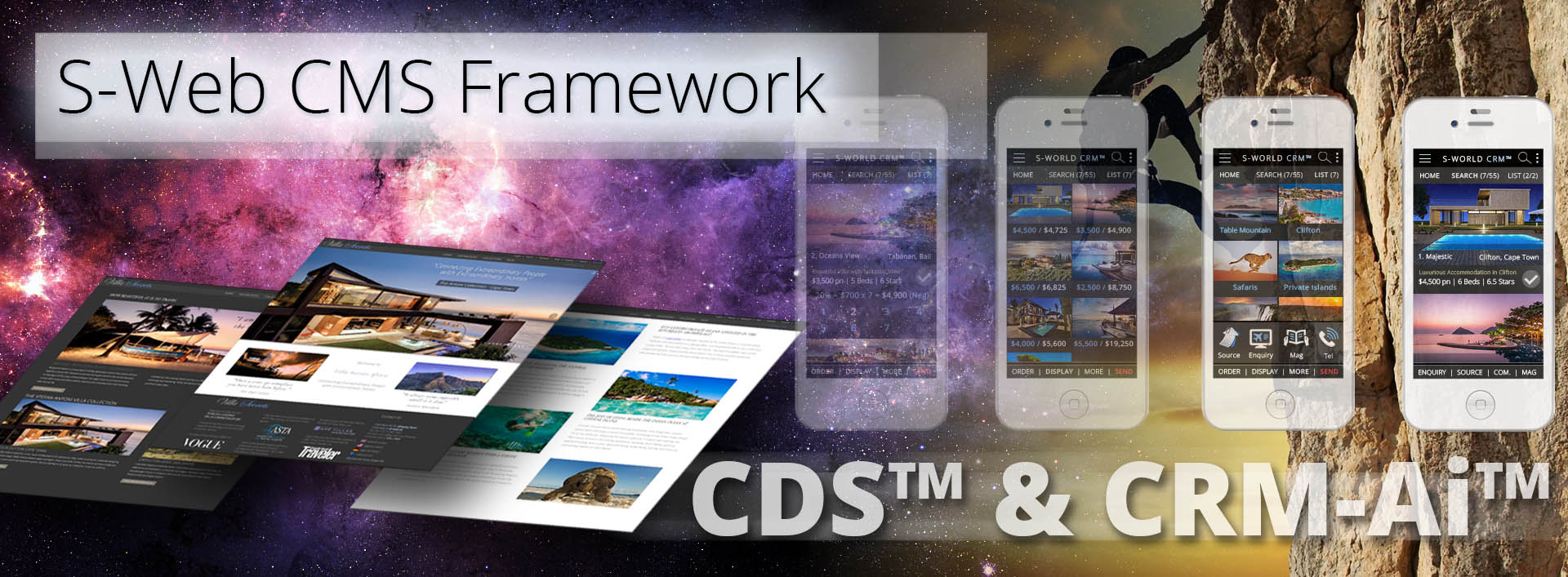
Putting aside any involvement from philanthropic or other investors, as this book is about certainty, with the investment income we receive from the first Primary Network, (being $42,000 deposit moving up to $168,000 by the end of 2018) we can afford an additional 3 Senior Zend framework qualified programmers and an App specialist, creating a team of 6.
Given an October 2017 start, 3 Zend framework qualified programmers, added to our current super hero programmer Vineeth and our slick designer Piyush, plus an App specialist is all we need to create all the sections presented in the conclusion of this chapter by the end of 2018. (For the latest development timetable, see (or ask for) chapter 23.)
In this section, we find software integrated into the web framework that we are currently working on. Of which, most of S-Web CDS™ is complete, phase 1 of the Villas Cloud™ is complete and we are very close to a working alpha version of S-World CRM-Ai (sales assistant and automation).
First, we present the S-Web CDS™ which really is a truly original system that has become the backbone to many other systems. We did not set out to create this system, we were programming wild and free seeing where the wind would take us and it pretty much created itself as we expanded upon the S-Wen CMS Framework.
S-Web CMS Framework Part 3
a. S-Web CDS™ – Content Delivery System
After creating the homepage CMS, we had a problem. We wanted the Villa Secrets website to be like a magazine, not just a directory of products. I wanted most of the links on the homepage to lead to quality articles about various products or locations, not just links to products.
So, we needed to create an Articles CMS, and it was in building this that we managed to make it so well that after the 10 minutes or so it would take to create an article header, a short description and a 60-word introduction; we could create an full rich content article within a minute.
Please watch this three-minute video presentation: https://youtu.be/X9-o3E4n2Dk to see me create an online magazine article in less than a minute (once the title, description and 60 word introduction has been created).
To see the article I made in the video, follow this link: www.villasecrets.com/Magazine/6-Exclusive-use-Safari-Lodges-to-fly-for-By-Nick-Ray-Ball/6811.
One minute to create an article that when including all the original copywriting, photography, and image editing used to take us about 3 days.
The trick to it, that turned a task that took hours into a task that takes minutes, was that instead of just making a template for a new article, we gave the user the option to call in the pictures and 60-word introductions and other details from product pages and from other article pages. And this simple action empowered the user after writing an introduction paragraph, to call in a variety of different products and articles to create a well crated image rich page, in less than a minute. Including the eye-catching picture slider at the top of the page, in responsive design looking great on mobile as well.
Hence the name ‘Content Delivery System’ (CDS) as we deliver previously made content into new pages, or newsletters, emails and even specialist web pages created specific for an individual client.
S-Web CDN ™ (Content Delivery Systems)
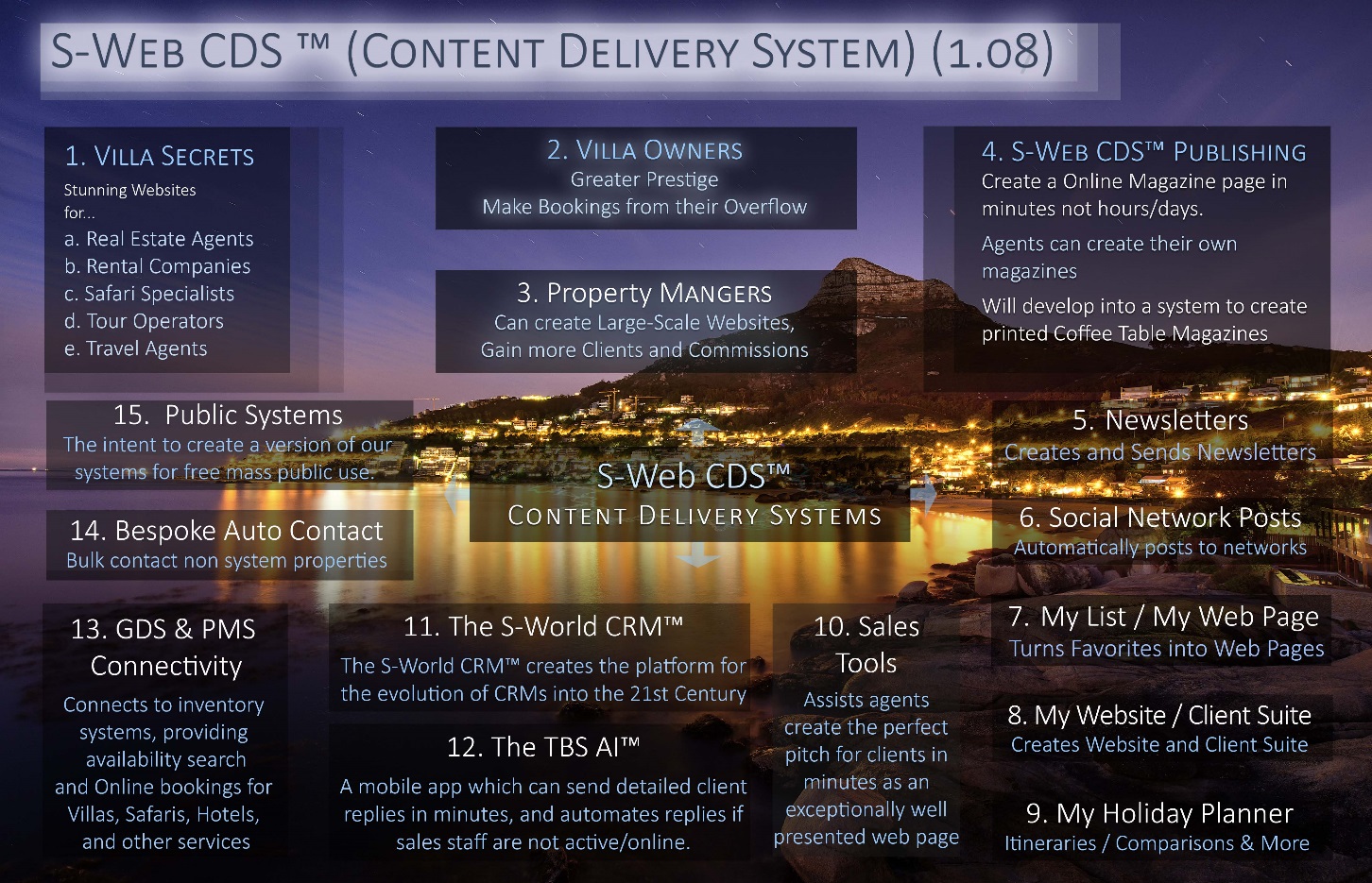
One may recognize the graphic above as a predecessor to the full 25-chapter Villa Secrets’ Secret business plan. That’s how important S-Web CDS™ is in terms of linking the S-Web framework into the core of the business, it was the magic source in creating super-fast and simple web page creation.
Once we had the framework design and could make article pages in seconds not days, it was an obvious jump to create an online magazine.
S-Web CMS Framework Part 3
b. Online Magazine, Newsletters, and Printed Media Publishing
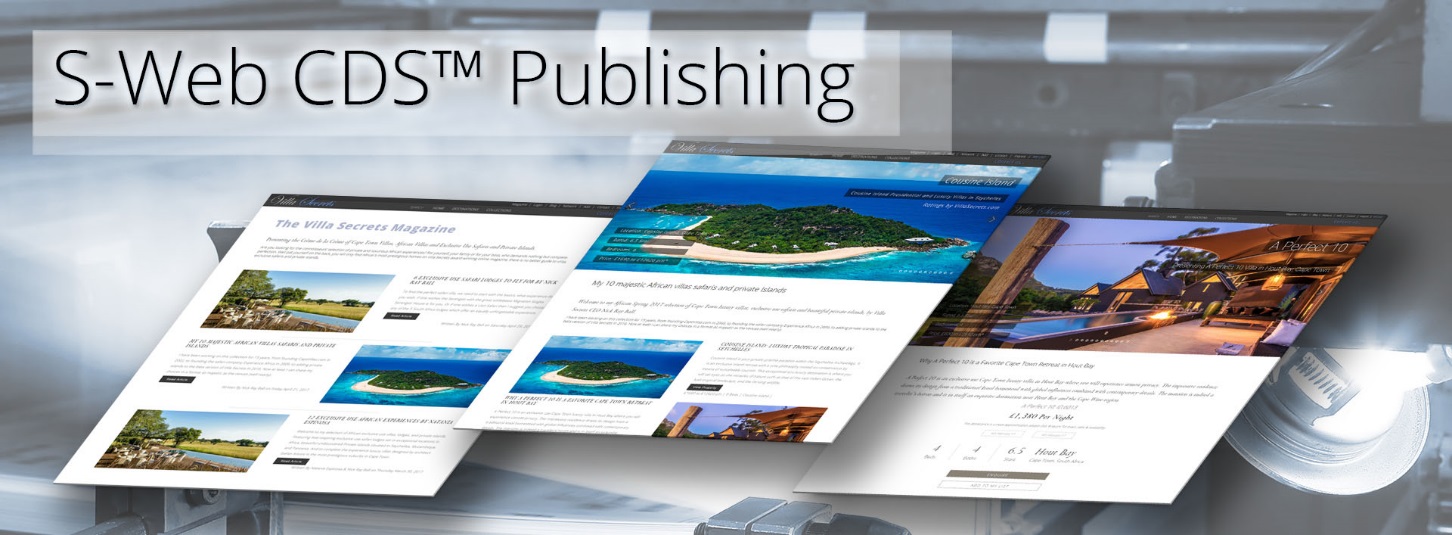
Welcome to the S-Web CDS ™ (Content Delivery System), the Villa Secrets Online Magazine, Printed Book Publisher and Newsletters.
www.villasecrets.com/Magazine
As we can create articles in minutes, each Villa Secrets company can go blog and magazine mad, with each sales staff members having their own magazine featuring their own articles made in no time at all. This improves the website, is the key foundation of a good content marketing strategy, and is a great addition to the CRM (customer relationship software) as the sales person and send an article a week to their previous or current clients.
Personalised magazines will give the client a far better impression of any sales person as they will seem knowledgeable, involved, and passionate about their products and insights.
Plus, it is infinitely better to ask a client if they would like to receive their sales person’s personal magazine, in terms of sustainability of the magazine newsletters, as people only have time for so many newsletters, choosing to unsubscribe to most. The fact that they will not be receiving newsletters from Villa Secrets, rather their agent that they know at Villa Secrets, will greatly decrease the chances of the newsletters being unsubscribed.
Printed Magazines and Coffee Table Books.
We can see the very well-considered plans for the Villa Secrets Coffee Table Book in chapter 18. Following on from the last magazine ‘Cape Villas’ that was distributed by Condé Nast Traveller UK, creator of our biggest booking by far, acclaimed by Bulgari who offered $100,000 in barter items to be the principle sponsor of the follow up.
For now, we shall just lay out the technology and its really simple. We adapt the current CDS™ and create a selection of CMS pages for different book or magazine page layouts, with the ability to move the +/- 60-word text block around each page, then convert it to a PDF, give it to the printer and hey presto that’s 50% of the cost of the average print publication saved. Plus, we get to make a very well laid out online version at the same time, and can make updated version of the magazine very simply.
S-Web CMS Framework Part 3
C. My List / My Webpage
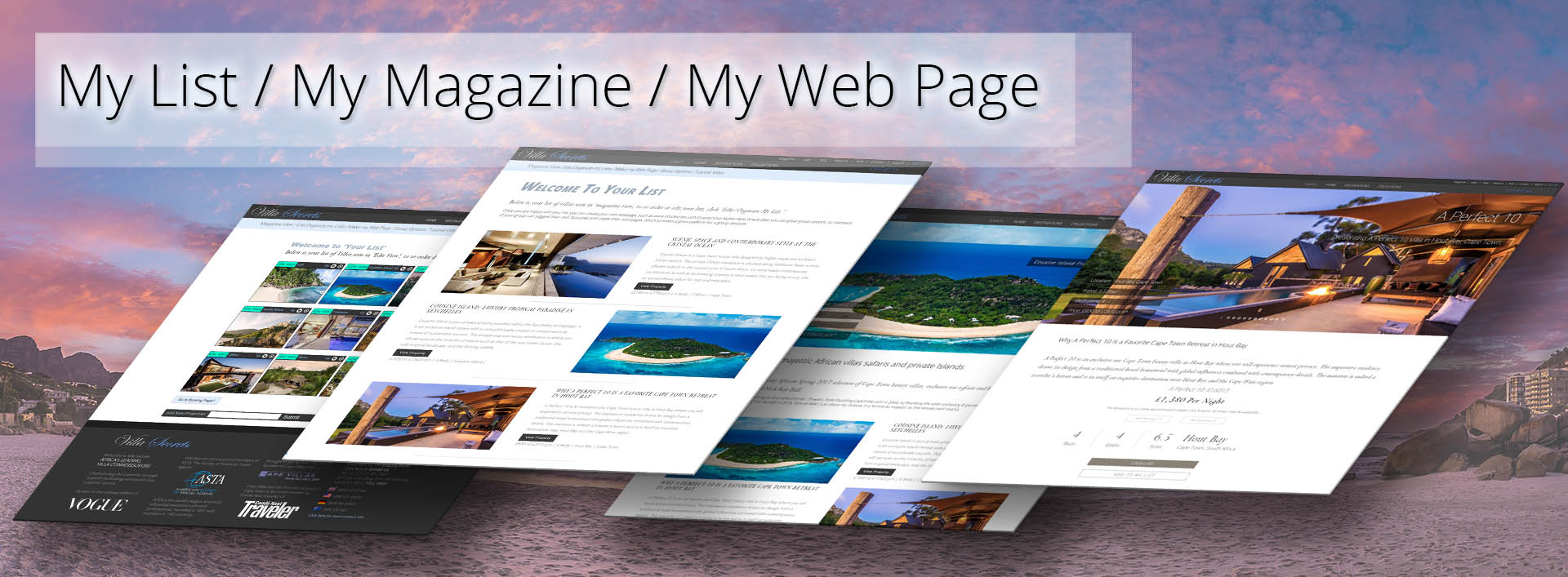
Welcome to MyList / MyMagazine / MyWebpage, in which we give clients the option to turn there ‘my favourites list’ into a magazine display and then a unique webpage.
Please watch this 2-minute video https://youtu.be/JS8vJQ1KxbM
And please try it out yourself by making your own Villa Secrets webpage
1. Visit www.VillaSecrets.com
2. Go to ‘Destinations’ > ‘Best of Africa’
3. Add a handful of villas to ‘your favourites list’ by clicking the plus symbols
4. Go to ‘Magazine’ and add some articles
5. Click ‘MY LIST’ at the top right of the page.
6. From the blue navigation menu under the logo click: ‘Make my Webpage.’
7. Add your client, boss, or partner’s name, email them, and click ‘Publish my Webpage’
8. Click ‘Add Comment’ to start a very organised conversation.
This journey is as unique as the last, and built upon the same principle, but this time we create a tool for guests to use. S-Web CDS™ MyWebpage begins with the standard ‘My Favourites’ function, www.villasecrets.com/MyList.php and presents a good-looking page with properties that can be dragged and dropped into order.
We build upon this by giving clients the option to then see their list displayed in magazine mode, which is a superior presentation, and then the clever bit… we offer a super simple way for the client to create a unique webpage, such as www.VillaSecrets.com/NickRayBall or any name one wishes which he/she can send to their wife, husband, partner, boss, or any others in the group.
This accomplishes several objectives: It captures the clients email address and lets us know which villas he/she likes and it increases the likelihood of a client booking as the more time they spend amending, showing the webpage to others, the less time they will spend looking for alternatives.
In addition, the list function can help the client become a motivator within their group, even if others in the group are talking to other agencies. The lists tools can win the day, as the organization of the list is far superior to any list of links via email one party in a group may send another, and as the others in the group can make their own list, this organizational tool can and will often win the day.
S-Web CMS Framework Part 3
d. The Villas Cloud™ – Online Availability & Bookings

Moving from chapter 4 to chapter 5, the Villas Cloud™ is currently all about live availability. In time, it will grow to include a property management system and distribution channels, however due to politics these functions may well be created as or by separate S-World companies.
Currently we are only focusing on fetching availability data live, so our clients can search for villas that are available to book now, and our agents can simply look on our website to find properties that are available. And so, we can build upon the ‘MyList / My Webpage’ CDS™ functions and enable the CRM-Ai™ to automatically reply to clients by email, presenting villas that are available to book.
Currently we are connected to MyBookingPal and show their Cape Town properties, currently we are adding villas in California and soon we will start with other systems. Across the world there are hundreds of systems that we wish to connect to, including many smaller systems or agencies’ own inventory databases.
S-Web CMS Framework Part 3
e. S-World CRM-Ai™ – Automated tasks
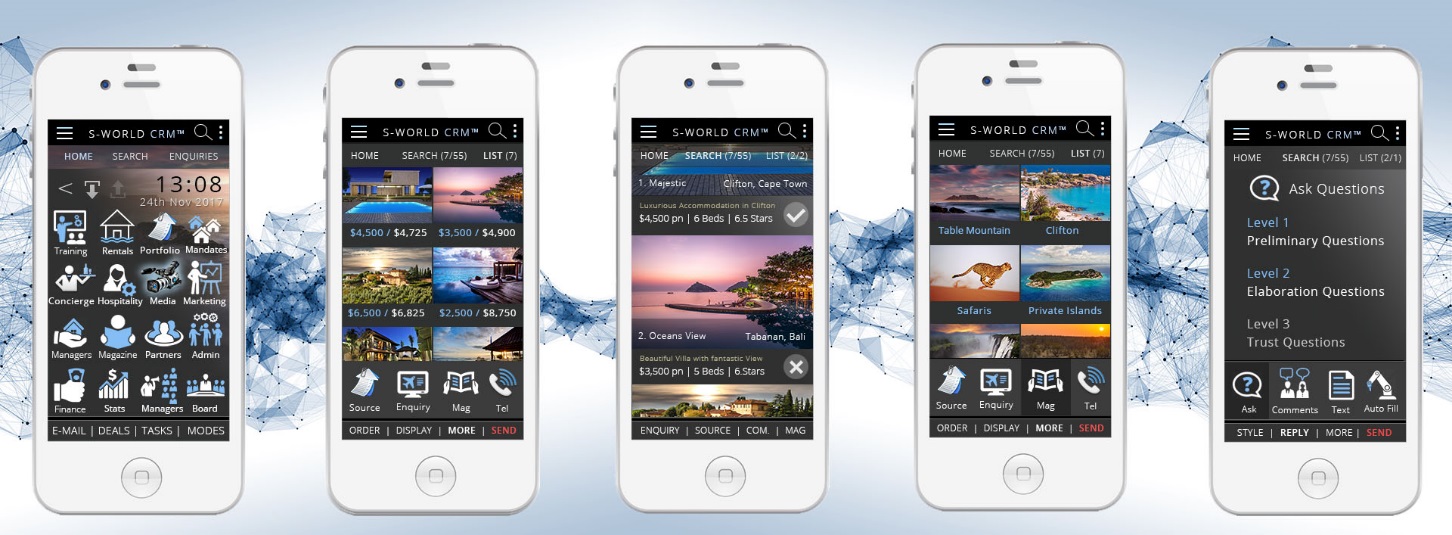
Now we move into chapter 6 and the CRM functions, functions that improve sales and the customer experience.
In a nutshell, the CRM-Ai™ or as it is also called ‘the Raybot’ is designed to automate the enquiry process, by analysing the enquiry data and creating an email response of a quality far beyond any current automated system, which can be automatically sent after 5 minutes; if a local or call centre agent is not available, steering the client to their webpage/client suite, to refine the search criteria and answer important questions. Then follow up and keep the lines of communication open until an agent is available. (Note that statistics say the chance of making a sale decreases by more than 50% if an enquiry is not answered within 5 minutes)
Whilst it can run on auto pilot, the CRM-Ai™ is designed to work with agents. So, going back to the 5-minute time point, if the agent picks up the enquiry before this their reply it is already very well organised. And if the agent is out viewing a property or it is out of office hours, they can work with the CRM-Ai™ from their cell phone, from desktop or mobile within just a few minutes the agent can send a quality and well researched reply to any new or ongoing enquiry. Including prompts that take heed from innovative sales methodology and psychology, such as three levels of questions from ‘The Science of Selling’ by David Hoffeld,’ which assist the sales person to influence the client and help close the deal.
The system will automatically contact all ‘bespoke’ properties, (properties that are not on booking systems) be them villas, safaris or private islands by email. And as the property managers of such accommodations click the ‘yes, the property is available’ button on the email, the property is added to the list and sent to the client. This single point is massive as it does something no other agent would do, or at least no other agent is currently doing, and that is to contact all ‘bespoke’ properties that match the enquiry, not just the few that the agents immediately think of.
To use the system, one starts with the search results created from the enquiry, of which the Ai will have picked 3 or 4 properties to send to the client, and will have added a few magazine articles at the bottom of the email. The agent has the option to change the villas, simply by scrolling down the list and clicking the tick or cross button, in the search.
One particularly useful function will be the ‘see commission’ option, below we see that in action. First on the left we see the initial enquiry and the 5-minute countdown. If the agent picks up this enquiry they just need to look at the list of available villas as seen in the second phone (note this functionality as already complete) and tick or untick the properties to send. Next in phone 3, the agent has hit the ‘Com’ button and the commission and total income made from the booking is displayed. Then in phone four on the right, the agent has chosen a different view showing more villas on a page that can be reordered easily, and which display the price per night and the commission made.
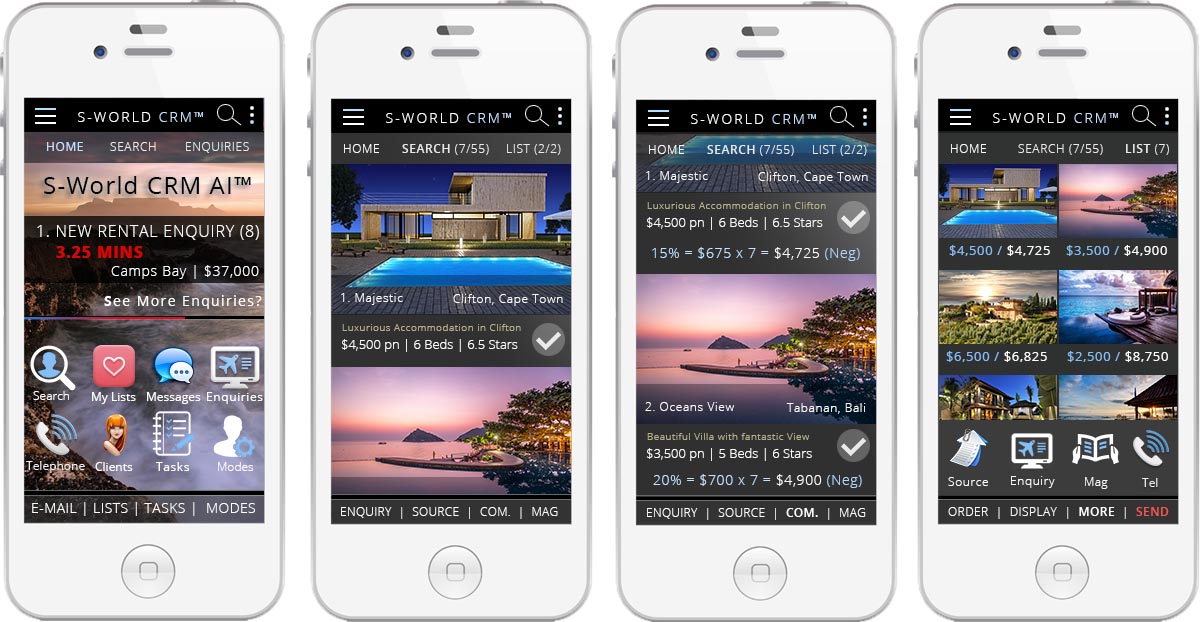
Below we see the second half of the journey. First, the addition of 3 magazine pages. Then the email format which can be charged at the tap on a button, followed by question options, carefully created to suite not just the industry niche but also the location.
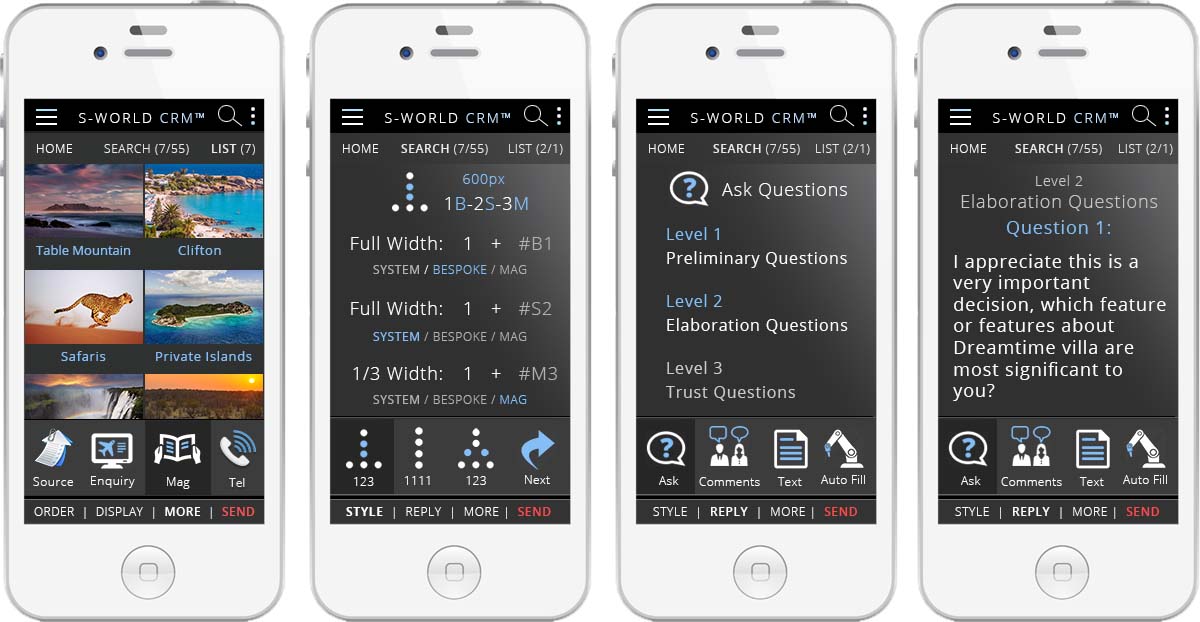
These questions are carefully created to engage the customers subconscious and to make them focus on why they like the properties they select or choose, and are in fact good service in general as they provide the sales person with insight into what the customer’s primary buying motives are; and so, the agent and the system alike can better recommend properties.
Once the questions have been chosen, the email is ready to send, which can be followed up with a phone call. A phone call that will be all the better for the agent having used the CRM-Ai™ and learned how to ask good questions and other sales techniques that the CRM-Ai™ provides, such as ‘How many properties should one send in the first place?’
However, if the agent is out of hours and the call centre is not yet in operations, we can target the ‘very important’ enquires to be sent to them, which using the CRM-Ai™ cuts the time it takes to do the search and make a well-considered reply down to just a few minutes. And as such with only a few or maximum a dozen enquires per day being ‘very important,’ it’s not an imposition to expect top agents to use be available to answer big bookings in most waking hours, which we know from experience can greatly increase conversions. (bookings and sales)
When the client receives the email it will have added an introduction, a key 2nd level question, a link to the client suite, the photos and the description for each villa (usually 3), a link to a search results page to showing many more villas, a row of magazine articles, possibly more 1st level questions, and a conclusion.
Where after the client can either go to their client suite, which is currently their My List /My Webpage page, or they can reply by email, or pick up the phone. And if client is calling from the UK, USA, Germany or Australia, the call is free. And a ‘Call us Toll Free’ button will be added to the email, and shown on line.
Development
Currently as of the 9th July 2017, we have created about half of this is desktop format, the property display on mobile, the client suite and dedicated webpage, and the CDS™ functions, plus we have created many email templates.
We need to make a CRM login that shows the website as normal, but with additional data, such as the commission rate, then sales people can simply use the CDS™ My List /My Webpage to finalise the property options, and we need to add a page that changes the email template and question options, then connect it to the email template, which will be done soon. Once achieved we have a tool for desktop that a new sales person can use to create replies to enquiries like an experienced agent, or can assist an experienced agent to work 2, 3 or even 4 times faster and do the job of many, which saves a lot. As with greater productivity a sales agent can make more money on a 10% commission that they would getting a 20% commission in a less efficient manner.
Once the basic, but still critically useful version described above it made, It will take some testing to get the questions right and a slick desktop version working. And due to the need for the priority of other systems and in particular the TFS™, the current development schedule for desktop version 2 is March 2018 with the Mobile App targeted in May 2018. However, we can create a basic version of the mobile APP when we make desktop version 1.
Important clarification; as far as creating a working tool for desktop that a new sales person can use to create replies to enquiries like an experienced agent, or can assist an experienced agent to work 2, 3 or even 4 times faster and do the job of many, we can create this within 2 weeks of when we choose to start this project. And as such will be ready for the sales team when they start, because we know that without this tool they will be only half as effective.
S-Web CMS Framework Part 4 (In the development que)
a. S-World TFS™ – Total Financial System

Since 2011 the primary objective of S-World Villa Secrets in terms of systems has been to create a simple financial system as a part of the core software design.
In 2011 the first version of this business plan found at www.s-world.biz/TST/The_Virgin_Business_plan_in_Retrospect.htm combined a CRM (customer relationship management system) alongside a financial system, and a GDS (global distribution system) which provided access to online availability, as was previous presented as The Villas Cloud™.
But before we get into detail a quick summary of the TFS™ development timetable. Which, if we can start by September 2017, we can complete an alpha (basic) version by January 2018. Which will be all that is needed to give management the correct financial overview, updated weekly and 100% accurate, showing monthly income vs expenses, management accounts, profit and loss, and a simple way for financial admin staff to update the system.
To many, the idea of creating financial software may seem a highly specialised art, but it’s really not, at this basic level it’s actually one of the easier projects. There is a general rule to consider in programming and if something can be created on a spreadsheet, it’s simple to create a database version. All one needs to do, is be competent at making CMS pages, to display the data in simple fashion, and as this entire chapter is about our S-Web CMS Framework, we have this covered.
The trick to the system that is unique (as far as we know) is how we avoid human error and make fraud much harder, which is to download the banking data as a spreadsheet and upload it into the system, along with a screenshot of the banking page, which may sound a bit old school, but it works.
We are yet to create the ‘Mobile First’ design, but I am looking forward to it. Chapter 7 expands upon the TFS™ and provides ‘Emotional Impact’ sections that present a series of problems and solutions gained from 10 years’ experience of financial managers and accountants (who should have known better) getting it wrong time and time again; and how the TFS™ has learned from this and makes a simple platform for Villa Secrets companies to avoid such problems, allowing them to focus on their strengths and reaching their and the companies’ potential.
S-Web CMS Framework Part 4
b. S-World CRM CC™ – Company Controller
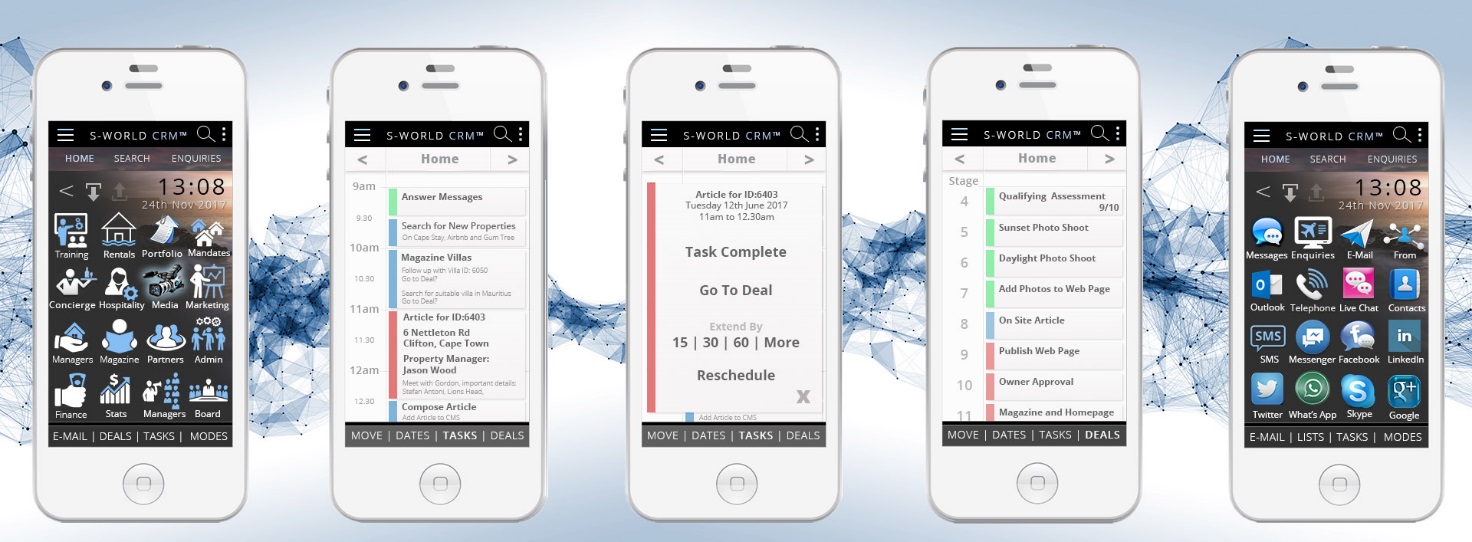
Welcome to the S-World CRM-CC ‘Company Controller.’ Taking control of each Villa Secrets partner company.
We have seen how the S-World CRM-Ai™ ‘Raybot’ allows a good sales person without experience in the industry to take control of the booking process in all waking hours, effectively doing the job of a small sales team on their own with greater efficiency. Now we look at monitoring and incentivising the entire team, from the intern to the CEO.
Whilst this was originally created to manage staff production and performance and a way to avoid the need for an operations manager or MD, since creating the plan and chapter; an even greater motivation for the use of this system has be unveiled within ‘The Science of Selling’ by David Hoffeld.
Hoffeld describes how an experiment in staff motivation yielded surprising results. In the experiment, 50% of staff were given additional work based benefits. But after the experiment, when the data was examined, productivity of all staff improved. This went back and forwards with different motivations and even a group that had their benefits removed. But no matter what, performance just got better and better, even for those who had lost their benefits.
So what in going on?
The incentives that motivate and encourage staff were not as powerful as the simple act of observation, they call it ‘The Hawthorne Effect’ (also referred to as the observer effect) in which individuals modify an aspect of their behaviour in response to their awareness of being observed.
And so, the CRM CC™ is doubly useful, it not only monitors and tells staff which tasks to do, it increases their performance by giving the impression that staff are constantly being observed.
Like the CRM-AI™ we are developing this system ‘Mobile First’
Below we see the design for the CRM-CC™ (Company Controller). The second icon you see ‘Rentals’ would lead you to the CRM-Ai™. The rest of the icons lead to different user types or functions including: Training, Villa Rentals, Portfolio Management, Mandate and Best STO acquisition, Concierge, Hospitality, Media Production, Marketing Objectives, Property Managers, Magazine Creation, Partner Deals, Admin, Financial, Stats and Sales Funnels, Managers & the Board of Directors.
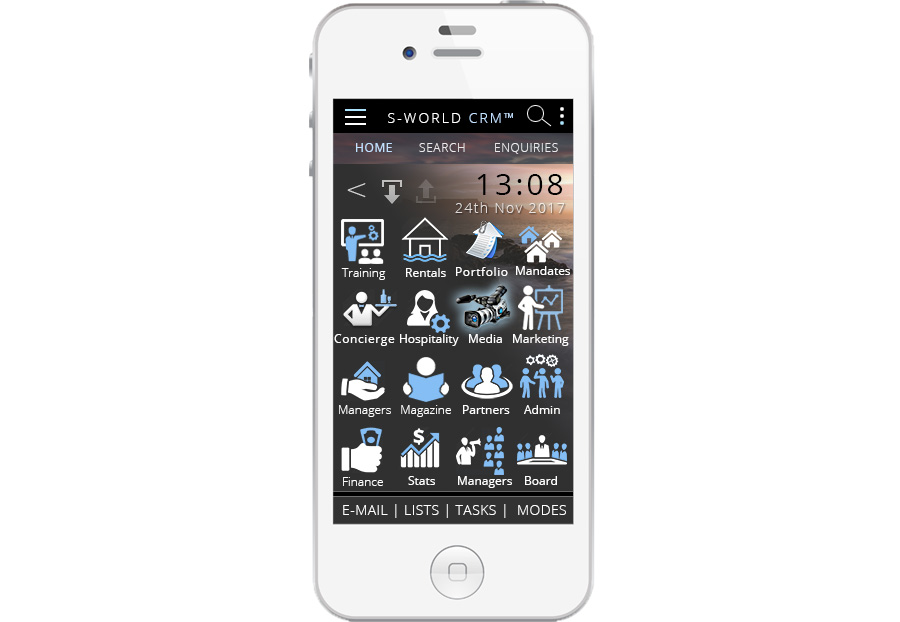
In the initial version we are only including functions we can create quickly. All we require right now is a calendar & planner, deal steps, targets and incentives all wrapped up within a game of sorts that gives points per completion of task, booking or sale.
Day Planner and Alerts
One of the big tricks to create the calendaring is in a way that it has ‘important tasks’ and ‘tasks that are useful but not essential.’ So, if a task takes longer or is delayed, the entire timeline can be shifted back keeping the important date sensitive tasks, and tasks that require collaboration in their original dates. To accomplish this, we start by spreading out the essential tasks, with plenty of time in-between each, which is filled with useful tasks, such as prospecting for new villas and mandates. And if there is a delay, all the nonessential tasks get moved back whilst the essential and time sensitive tasks stay in place.
Below left we see the day planner in task mode, which assigns different colours to different tasks based on importance. Green is for an important regular task that should not be missed. In blue, we see tasks assigned that can be put back if a more pressing task arises or if a previous important task has overrun. Then in red, we have tasks that are very important, usually involving a meeting, collaboration, or a deadline.
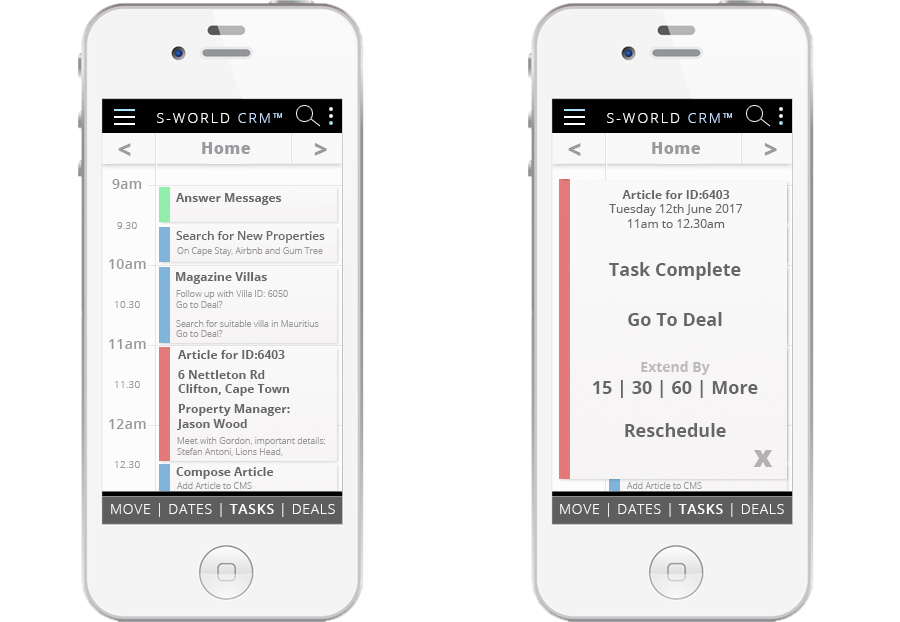
In this scenario, the staff member with the dual role of copywriter and portfolio manager has a meeting with a property manager at a villa at 11am to 12.30 in the afternoon.
Above right we see the alert that beeps and pops up at the end of the task time, from which the user can click ‘Task Complete’ (which will update the corresponding deal), or click ‘Go to Deal,’ ‘Extend Time,’ or ‘Reschedule.’
Sole Mandate & Best STO Deal Preparation
STO stands for ‘Standard Tour Operator Discount’ and is the difference between the ‘public rate’ charged by the property and the discounted rate offered to the agency.
In the graphic below we see the ‘deals’ page, which will have automatically updated as soon as the copywriter / portfolio manager has clicked ‘task complete’ on the previous graphic, moving deal stage 8 from Red ‘not complete’ to ‘green complete’ (as the deal stage is currently in progress, it is in blue).
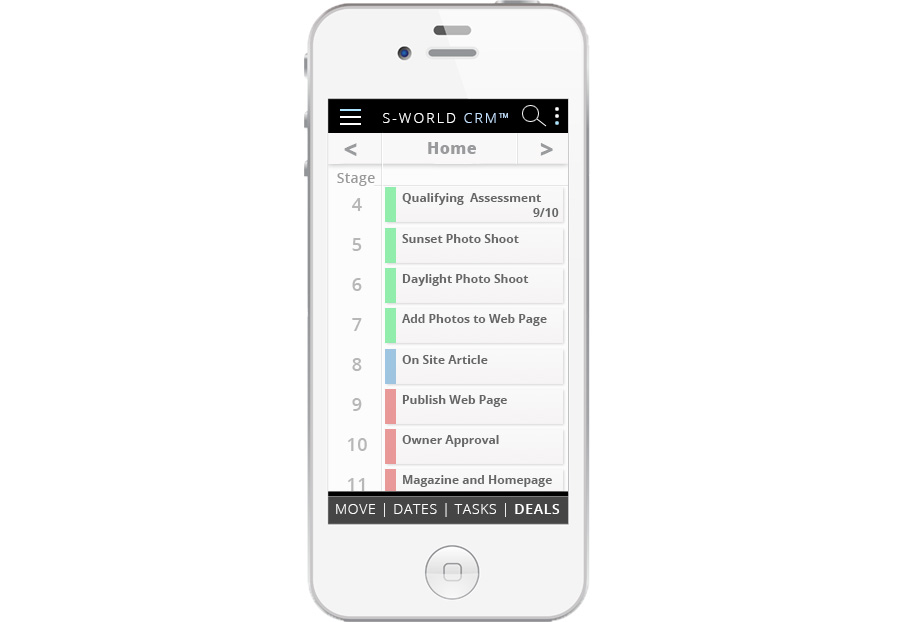
There are 11 different stages to this process that happen before we pitch for a mandate:
1. New property identified
2. Basic details received
3. Got images
4. Qualifying assessment 1 to 10, where we prioritise higher numbered properties
5. Sunset photo shoot
6. Daytime Photoshoot
7. Add photos to webpage
8. On site article
9. Publish web page
10. Owner edits/ approval
11. Magazine article & home page
This last deal stage is where magic can happen. Not only does the villa webpage look this awesome (www.villasecrets.com/Villa/North-Island-Villa=6061) but in just a few minutes we can create an online magazine article, presenting it as the featured villa in an illustrious company within a pan African mega villa article, which also temporarily adds the property to the home page.
When the web page, mega article and home page are presented, this is the point where managers and owners see Villa Secrets as the company that goes the extra mile. And that is the time to start the pitch for a mandate, as an experienced and seasoned sales mandate specialist joins the portfolio manager to help bring home the opportunity, following a different deal path specific to the task.
Even if a mandate is not secured, one will have made better friends with the manager and owner and may get a better STO or better bespoke discounts for quality bookings, and we have more great content for our clients to look at and other websites to link to.
S-Web CMS Framework Part 4
c. S-World UCS™ – Competitive Games, Fun and Addictiveness

Following on from the conclusion of the reframe in step 2, S-World UCS is a massive system initially considered in 2003 as a management game called ‘Villa Mogul,’ in which players could run their own version of Cape Villas.com and expend upon it to forge a global real estate empire.
The difference between this and other management games at the time was in part our unique virtual tours providing better graphics, but mostly as it would be the first game based on a real business, it would have significant PR benefits for the parent villas company, and networking benefits as gamers could win the rights to open their own international franchises. Well that was the 2003 thinking, which is now upgraded into the S-World Network, as is presented in chapter 2.
Eight years on, in 2011 the first of the 11 point travel plan we created with Facebook in mind www.s-world.biz/FaceBook/1_The_FaceBook_Travel_Tutorial_Game.htm taught users to appreciate and learn both the industry and our systems, before trying the business for real.
Then in 2012 in the final chapter of the first American Butterfly book: ‘The Theory of Every Business’ expanded upon the theme with the more inspirationally titled ‘Universal Colonisation Simulator’or S-World UCS http://americanbutterfly.org/pt1/the-theory-of-every-business/ch8-s-world-universal-colonization-simulator.
More recently, in Angel Theory’s ‘M-Systems,’ S-World UCS is the foundation for 3 of the 16 M-Systems. And believe me it’s quite a ride.
And now, finally after 14 years of consideration and planning we get to start the system as a part of CRM-CC™.
The basic principle is that we have allocated significant funding for profit share, which materializes (pays out) when the primary network reaches its R10million / $750,000 in gross profit (in commissions earned) within a 12-month cycle. Which we would like to do by the end of 2018.
It’s a simple enough system to program, each task completed, each best STO or mandate secured and each booking has a points value, and as staff and management complete their tasks they win points. And each day, there is a points winner, and the points winner gets a percentage of profit share.
Created in this way, we can allow for a sales agent to bring in a big booking, or a property networker to land a mandate and receive a huge score on that day. But the next day everyone starts from scratch, so on any given day any one can win. And that’s important to the game play, and will encourage staff to perform simple tasks such as increasing Facebook likes, or writing tweets in the spare time, as each action has small points score and the cut of time for scoring points is the end of the calendar day.
It also allows management to steer the team in the direction of gaining mandates and adding properties. As whoever adds a property will see point wins every time that property is seen on the website, and more points if its booked; and more still if its booked and it makes a lot of money. This not only focuses staff on adding properties, but also on adding properties that will make money and adding them as well as can be done, as in doing so they increase the chances of being seen and booked, and so more points, prizes & profit share. (Prizes potentially coming in the form of handbags, glasses, perfume and after shave from brands like Bulgari in exchange for adverting space in the Coffee Table Books from chapter 18)
This competition is more about motivating the support staff and management, than the frontline sales and mandate staff, as such staff are already motivated with commission and in many cases, will be shareholders in the company itself.
There will be a great looking winners page that shows all points won each day and the daily top 3. And from that point we can create weekly competitions in both days won and total points, and monthly and 3 monthly competitors which will pay our significant bonuses for winners.
This is what turns the S-Web CMS Framework from simple and beautiful to simple, beautiful, fun and addictive. And as a bonus, as well as the motivation of being a daily or weekly winner, is that we create a very observed view point on each staff member on each day, and so ‘The Hawthorne Effect’ kicks in improving overall performance from all team members. It also makes a bridge to Angel Theories’ M-system 12, but we need not get into this here.
Development Timetable
Initially within 2 weeks of a request to move on this system we can create a basic version of both the CRM-CC™ and UCS™ that will let all staff know their tasks and we can test the point scoring variables. After this basic version we are looking at May 2018 for the alpha version, with the beta version ready in November 2018.
S-Web CMS Framework Part 5
a. S-World TBS™ – Total Business Systems

The TBS (Total Business Systems) is the collection of all web and software systems under one roof, in this chapter we provide benchmarking data, ROI calculators, and an estimated improvement percentage that each component provides.
For some history follow these links:
S-World.biz (2011)
The Divergent CRM (2015)
Part 1 the Total Marketing Systems (2016)
Part 2 the Total Financial and Business Systems (2016)
Collectively the combination of all software found within the S-Web framework is disruptive, but what is a disruptive system?
From our vantage point, a disruptive system is a system that has taken longer to create, but when it enters the market it disturbs it, taking a larger market share than traditional companies in the marketplace without its advantages.
In 2002 our prototype website www.CapeVillas.com with its virtual tours disrupted the Cape Town vacation rentals market as a bunch of web designers create a company that would lead the market for 8 years.
However, Cape Villas has nowhere near the disruptive firepower and potential that Villa Secrets enjoys.
In this summary chapter of the TBS™ we start with potential negative factors, before zooming into the effects created by the different systems, and note that when it comes to negative factors for caution we over estimate, and when it comes to positive factors we under estimate. We call this ‘quantum safe forecasting.’
Below on the far right we see percentages estimated for phase 1 (2018) and on the left, are the full potential of each system when fully complete and tested, which could be many years away. In forecasting we only use the lower far right figures.
| Competitors and Other Negatives | Max Effect | Phase 1 Effect | |
| First Year Jitters |
-40.0% |
|
-40.0% |
| Airbnb |
-60.0% |
|
-36.0% |
| HomeAway |
-25.0% |
|
-12.5% |
| Other |
-50.0% |
|
-12.5% |
| Competitor Improvement |
-50.0% |
|
-12.5% |
| Total Negative |
-225.0% |
|
-113.5% |
Now for the positives, and note some of the systems below are not software generated but are instead staff functions, from photography to guest blogging to manning call centres.
| Portfolio Manager & Team | Max Effect | Phase 1 Effect | |
| Adding Properties for Agents to Rent |
50.0% |
|
15.0% |
| Subtotal |
50.0% |
|
15.0% |
| Concierge, PR, Film & Social Media | Max Effect | Phase 1 Effect | |
| Repeat Clients |
25.0% |
|
2.5% |
| Referrals |
10.0% |
|
2.0% |
| Attracted to come because of Concierge |
15.0% |
|
3.0% |
| Systems created to increase the above |
25.0% |
|
0.0% |
| PR |
25.0% |
|
2.5% |
| Videos of Villas Marketed |
25.0% |
|
0.0% |
| Films of Villas Syndicated |
25.0% |
|
0.0% |
| Concierge – Social Networking – Manual |
15.0% |
|
1.5% |
| Concierge – Social Networking – Automatic |
15.0% |
|
0.0% |
| Subtotal |
180.0% |
|
11.5% |
| S-Web Villa Secrets Web Framework | Max Effect | Phase 1 Effect | |
| Superior Visual Experience |
15.0% |
|
11.3% |
| Greatly Superior Mobile Experience |
20.0% |
|
10.0% |
| Advertise on Mobile Platforms |
10.0% |
|
7.5% |
| Subtotal |
45.0% |
|
28.8% |
| S-Web CDS™ (Content Delivery System) | Max Effect | Phase 1 Effect | |
| Clients Lists |
2.5% |
|
2.5% |
| Clients Web Pages |
5.0% |
|
5.0% |
| Online Magazine |
5.0% |
|
5.0% |
| Online Magazine posts to home page |
1.0% |
|
1.0% |
| Newsletters |
0.0% |
|
0.0% |
| Agents’ Own – Newsletters |
7.5% |
|
7.5% |
| Agents’ Own – Online Magazines |
5.0% |
|
5.0% |
| Agents’ Social Networking (SN) – Manual |
15.0% |
|
2.3% |
| Agents’ Social Networking (SN) – Automatic |
15.0% |
|
0.0% |
| Rest of staff – Magazine + SN – Manual |
5.0% |
|
0.8% |
| Rest of staff – Magazine + SN – Manual – Automatic |
5.0% |
|
0.0% |
| Client’s CMS |
15.0% |
|
0.0% |
| Agents’ Desktop Quick Quality Emails |
10.0% |
|
10.0% |
| Bulk Email Bespoke Villas |
10.0% |
|
10.0% |
| Upsell Villas, Safaris, and Private Islands Pt.1 |
10.0% |
|
2.5% |
| Subtotal |
111.0% |
|
51.6% |
| S-World CRM-Ai™ (Bookings Robot) | Max Effect | Phase 1 Effect | |
| Ai – Automated Replies at 5, 15 and 30 mins |
10.0% |
|
10.0% |
| Ai – Automatic Replies from Bespoke Villas |
10.0% |
|
10.0% |
| Agent – Better Organization for Ongoing Enquiries |
10.0% |
|
10.0% |
| Agent – Out of Office Replies |
15.0% |
|
15.0% |
| Agent – Saves Money on commission | |||
| Both – Upsell Villas, Safaris, and Private Islands Pt.2 |
25.0% |
|
3.1% |
| Both – Upsell All Travel |
40.0% |
|
0.0% |
| Subtotal |
110.0% |
|
48.1% |
| S-World TFS™ (Total Financial System) | Max Effect | Phase 1 Effect | |
| Financial System – Data Entry |
0.5% |
|
0.3% |
| Financial System – Data Sorting |
0.5% |
|
0.3% |
| Financial System – Data Reporting |
5.0% |
|
0.5% |
| Financial System – Sales Funnel |
25.0% |
|
2.5% |
| Financial System – Auditing & Tax |
2.5% |
|
0.3% |
| Subtotal |
33.5% |
|
3.9% |
| S-World Villas Cloud™ (Availability) | Max Effect | Phase 1 Effect | |
| MyBookingPal (Razor) – Availability Search |
10.0% |
|
10.0% |
| MyBookingPal (Razor) – Online Bookings |
5.0% |
|
5.0% |
| Nitro – Availability Search |
10.0% |
|
10.0% |
| Nightsbridge – Availability Search |
5.0% |
|
5.0% |
| Nightsbridge – Online Bookings |
5.0% |
|
5.0% |
| Nightsbridge – Africa Upselling |
5.0% |
|
5.0% |
| Subtotal |
40.0% |
|
40.0% |
| S-Web CRM-CC™ (Company Controller) | Max Effect | Phase 1 Effect | |
| Increases mandates | |||
| Lowers staff costs | |||
| Increases productivity |
10.0% |
|
10.0% |
| Hospitality Systems |
10.0% |
|
1.0% |
| Greater Collaboration |
10.0% |
|
10.0% |
| Subtotal |
30.0% |
|
21.0% |
| Total (Complete or in progress Systems) |
719.5% |
|
255.6% |
|
|
|||
| Minus Negative |
-225.0% |
|
-113.5% |
| Total so far |
494.5% |
|
142.1% |
When we add it up so far in terms of all the systems we have covered so far, we see that even after a very over-exaggerated threats assessment, for phase 1 (2018) we are winning by 142%.
And now for the original 2016 TBS™ in 2 sections, of which you will note that many of the systems have since been removed, and placed into the S-Web Framework products we have presented.

| The TMS™ (Total Marketing System) | Max Effect | Phase 1 Effect | |
| Bing PPC (Advertising) |
5.0% |
|
5.0% |
| AdRoll & Other Remarketing (Advertising) |
5.0% |
|
5.0% |
| Content Writing 1 (Now in Call Centre) | |||
| Photography (SEO + Social Networks + Experience) |
15.0% |
|
2.3% |
| Marketing & Advertising the Online Mags & Blogs |
10.0% |
|
2.5% |
| Syndication to Blogs and Mags (Guest Blogging) |
5.0% |
|
1.7% |
| Update to Social Networks (Now in CDS™) | |||
| Social Network Systems & Staff (For Main Sites) |
15.0% |
|
1.5% |
| Newsletters (Now in CDS™) | |||
| Guest Gifts (From Magazine Barter) |
15.0% |
|
3.8% |
| Villa, Safari & Island Brochures |
15.0% |
|
0.0% |
| Villa Secrets Magazine 1 (2018) (Run of 5,000) |
10.0% |
|
10.0% |
| Villa Secrets Magazine 2 (2019) (Run of 50,000) |
30.0% |
|
0.0% |
| Villa Secrets Magazine 3 (2020) (Run of 250,000) |
50.0% |
|
0.0% |
| Villa Secrets Films & TV Shows (Now in Concierge) | |||
| Villa Secrets Brand |
10.0% |
|
0.5% |
| Trade Memberships (ASTA etc.) |
5.0% |
|
1.3% |
| 24/7 365 Call Centre and Sales Team (Now in Call Centre) | |||
| Foreign language Sales Teams (Now in Call Centre) | |||
| 24/7 Live Chat (Now in Call Centre) | |||
| Mobile Sites (Now in S-Web Framework™) | |||
| Mobile Apps (For the Public) |
25.0% |
|
0.0% |
| Local SEO |
10.0% |
|
5.0% |
| Tutorials & Operations Manual |
10.0% |
|
2.5% |
| Awards Software |
10.0% |
|
0.0% |
| Subtotal |
245.0% |
|
41.1% |
| The TFBS™ (Total Financial Business System) | Max Effect | Phase 1 Effect | |
| Financial System – Data Entry (Now in TFS™) | |||
| Financial System – Data Sorting (Now in TFS™) | |||
| Financial System – Data Reporting (Now in TFS™) | |||
| Financial System – Sales Funnel (Now in TFS™) | |||
| Financial System – Auditing & Tax (Now in TFS™) | |||
| CRM – Advanced and Other Features |
10.0% |
|
2.5% |
| Enquiry System (Now in CDS™) | |||
| Clients CMS (Now in CDS™) | |||
| Sienna-Bot Ai (Now in CRM-Ai™) | |||
| Hospitality Systems (Now in CRM-CC™) | |||
| Experience Africa (Association Branding) |
15.0% |
|
1.9% |
| Experience Africa (Systems Developed for) |
15.0% |
|
1.9% |
| Experience Africa (Improved STOs) |
15.0% |
|
1.9% |
| PMS & GDS Connections (Now in Villas Cloud™) | |||
| Villas Cloud Booking System (Now in Villas Cloud™) | |||
| Distribution Channels (Now in Mandates) | |||
| Property Manager CMS |
2.5% |
|
0.6% |
| Owner’s ‘For Sale’ CMS |
2.5% |
|
0.6% |
| Property Owner/Manager Websites |
10.0% |
|
2.5% |
| Magic Menus |
5.0% |
|
1.3% |
| Magic Galleries |
2.5% |
|
0.0% |
| Projects (Now in CRM-CC™) | |||
| Analytics |
5.0% |
|
1.3% |
| Subtotal |
82.5% |
|
14.5% |
M-Systems
M-Systems are the advanced software design and networking plans. However, as these systems need assistance from Silicon Valley, we have only included some small effects created by the creation of the network in both Cape Town and Africa.
https://www.villasecrets.com/Best-Of-Africa
| M-Systems | Max Effect | Phase 1 Effect | |
| M-Systems 2. Cape Town Network |
30.0% |
|
3.8% |
| M-Systems 2. Africa Network |
20.0% |
|
5.0% |
| M-Systems 2 & 16. Global Network |
10.0% |
|
0.5% |
| M-Systems 5. POP |
25.0% |
|
0.0% |
| M-Systems 6. S-World Resort Developments |
25.0% |
|
0.0% |
| M-Systems 7. S-World Virtual Networks |
25.0% |
|
0.0% |
| M-Systems 14. Philanthropic Projects |
25.0% |
|
0.0% |
| Subtotal |
160% |
|
9.3% |
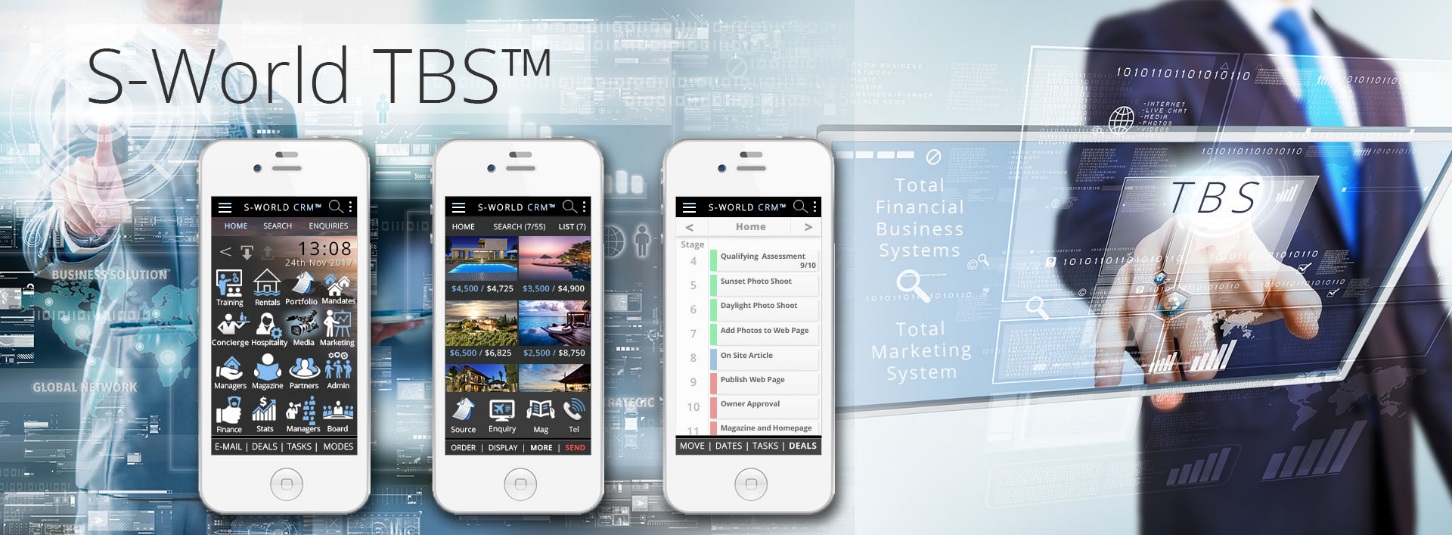
Finally, we come to the total of all the systems that are complete or in progress, plus all the TBS™ & M-Systems™, minus competitors and other negative probabilities, and we equal a positive 206%.
| Total (Complete or in progress Systems) |
719.5% |
|
255.6% |
| Other TBS & M-Systems |
488% |
|
64.5% |
| Competitors and Other Negatives |
-225.0% |
|
-113.5% |
|
Total |
982.0% |
|
206.65% |
(Note: the figures above are from Scenario 7.12c, future updates will differ)
This 206% figure is relative to the ROI one should expect from advertising an average to good website; with the bare minimum of staff, without any systems, and with no repeat business. So, for instance if a company was to make $100,000 in a year from $33,000 in advertising; the complete web framework, integrated software, and staffing as presented change the $100,000 ROI into $306,000 ROI
Whilst this may seem like a huge gain, it is a gain that started from nothing. If instead we were to consider one of Africa’s travel success stories, such as the award-winning Rhino Africa who have invested millions of dollars in their own system development and are very well staffed, we would basically be expecting to match their performance. This 206% is no miracle, its standard for many big spending companies. It just looks big as we started from a low bar, the bar most new small business would start at.
The simplest way to look at it is in terms of increasing performance in two areas.
1. Increase the number of enquiries made by visitors to our web sites.
(in this case from Google AdWords, but the same applies to all visitors)
2. Increase the amount of bookings generated from enquires.
-
Increase the number of enquiries made by Google AdWords visitors.
In 2015 the second Villa Secrets prototype www.cape-town-luxury-villas.com (CTLV) had 5,541 visitors (clicks) from Google AdWords at a cost of $12,107 at an average cost of $2.19. This lead to only 241 individual enquiries online which we roughly increase to 350 to include enquiries made by email or by telephone. As such about one in 35 Google AdWords visitors enquired.
If the much-improved website and CMS Framework, plus all systems both human and automatic can get this conversion rate down to 1 in 17 that is a 100% gain. Or better still if we can encourage 1 in 11 visitors to enquire (which is far from an unreasonable target) that’s a 206% gain.
-
Increase the amount of booking generated from the Google AdWords enquires.
This is a harder one to work out, as we have Google SEO and other enquiry sources all thrown into the Google Analytics mix, and we did not receive Nov or Dec CTLV figures. However, estimating CTLV made about 80 bookings from 350 enquiries that’s a closing ratio of 23%, just under one in 4.
If the much-improved website, S-Web CMS Framework, software and systems (both human and automatic) could collectively get this closing ratio up to 46% (just under one in two) then that would double return on investment again.
If we were to increase enquires from 1 in 35 to 1 in 11 and increase the bookings ratio to one in two, that would create a 414% gain, as the 206% gain is doubled.
And that’s where we go in phase 2 in 2019, as we build upon the 206% target and reach for a plus 400% increase in income made from advertising compared to the no systems 2015 CTLV prototype.
Villa Secrets and The Chan Zuckerberg Philosophy
Now that we have seen how by creating software within a web framework, including a plethora of unique and beneficial systems, we can give new small (Villa Secrets) companies the systems advantages only a big company enjoy. Which was the pre-2011 objective, and one of the key ideas that lead to the beginning of this project in the first place.
Based on the principle ‘if all systems are even’ then a network of small companies with an owner to staff ratio of 2 or 4 staff per stakeholder, compared to thousands of staff per owner big companies have, this single factor would lead to the small owner run companies greatly outperform the companies with low ownership vs staff ratios. For the exact same reason communism did not work, people will push their own efforts to the max if they will benefit from it, but take that benefit away and many people will do as little as they can get away with.
Maybe the above is a bit extreme, the point is people care more about things they own, but small companies are perilous. Take away that peril and add the systems advantages and a network of small owner lead companies will outperform their big company rivals. And as a by-product, this network model is the most potent way to create an environment that encourages potential, so falling in line with the main Chan Zuckerberg philosophy.
